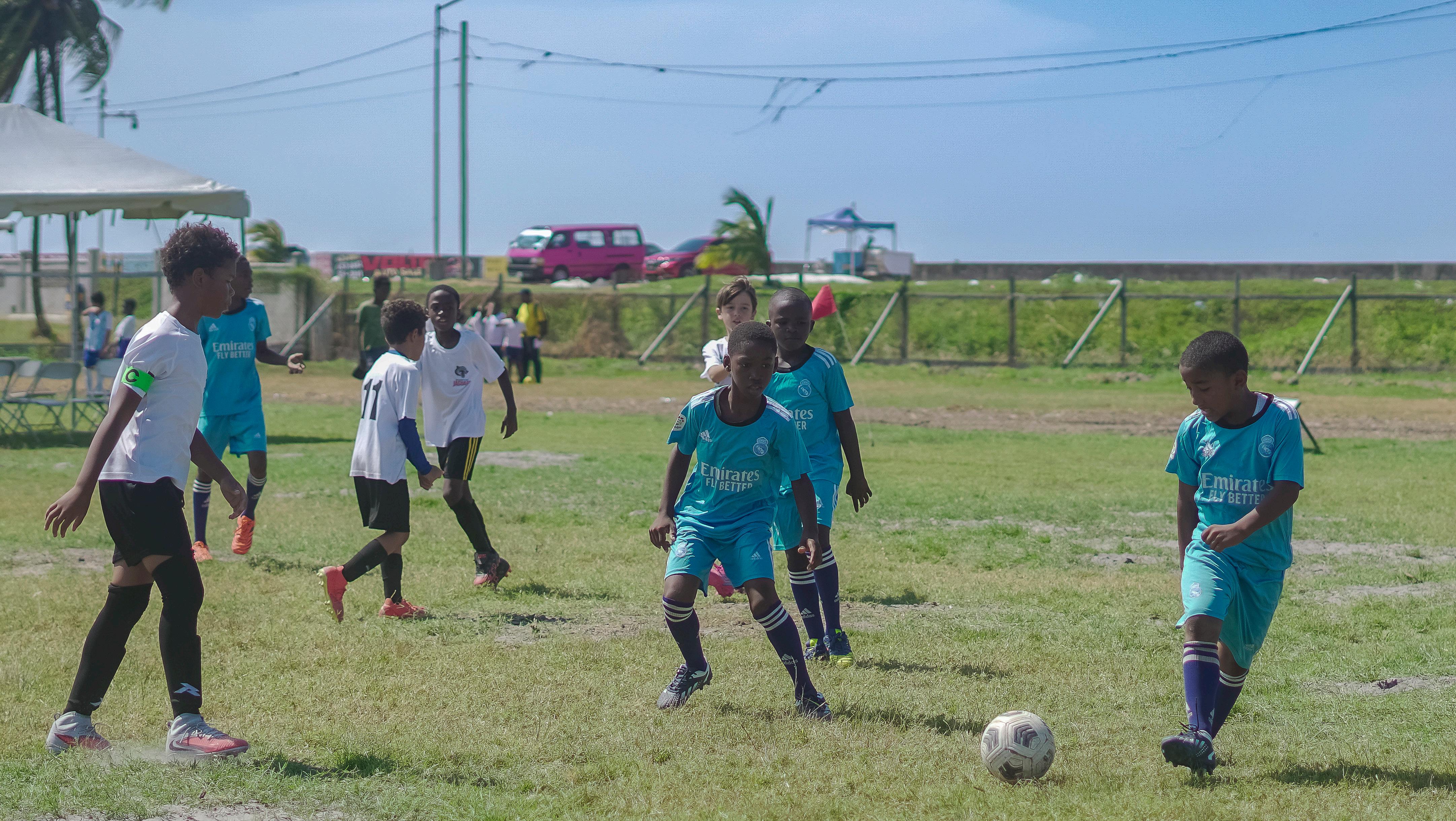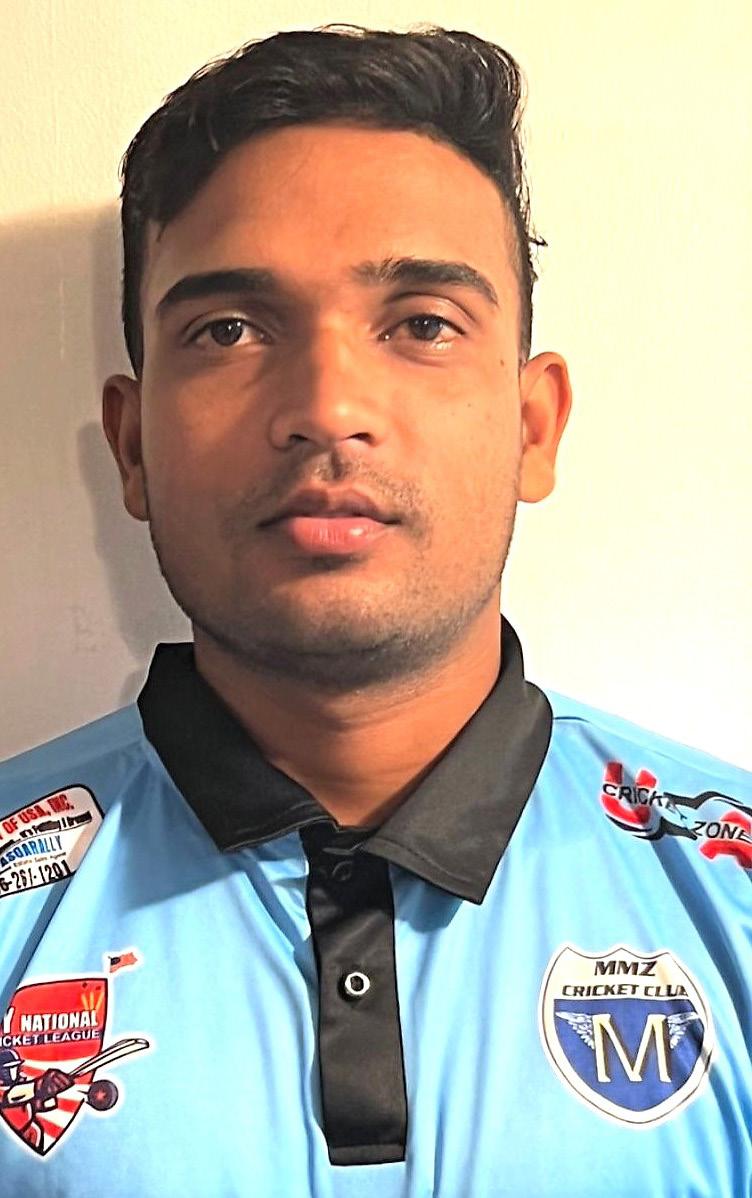






Guyana’s largest and most advanced thoroughfare to date, was officially commissioned on Sunday and named in honour of former President and Guyana’s current Vice President, Dr. Bharrat Jagdeo. Thousands of excited Guyanese and special guests joined President Dr. Irfaan Ali, First Lady Mrs. Arya Ali, their sons Masters Zayd and Ilan, members of the Cabinet and other officials for the historic event (Delano Williams photos)




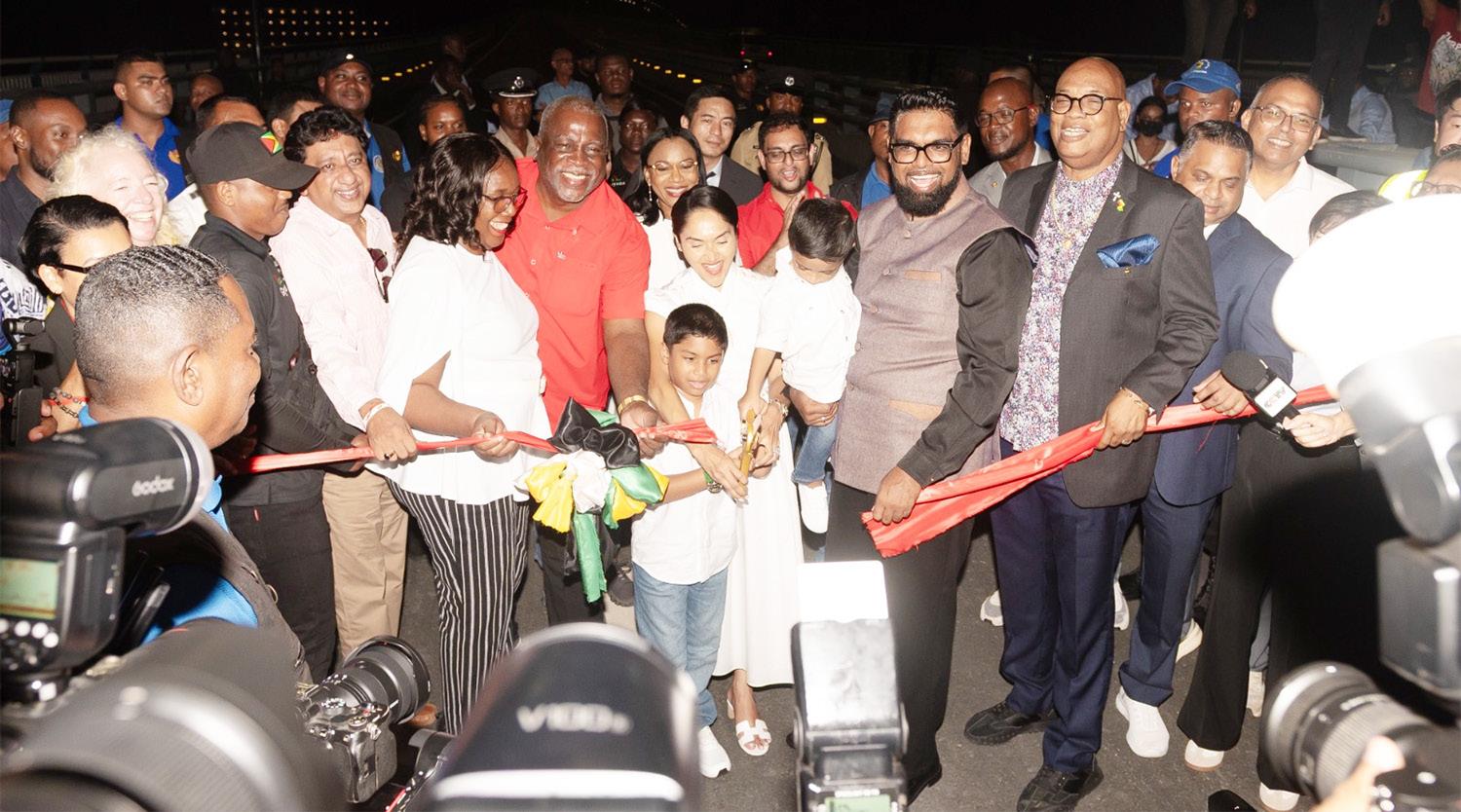
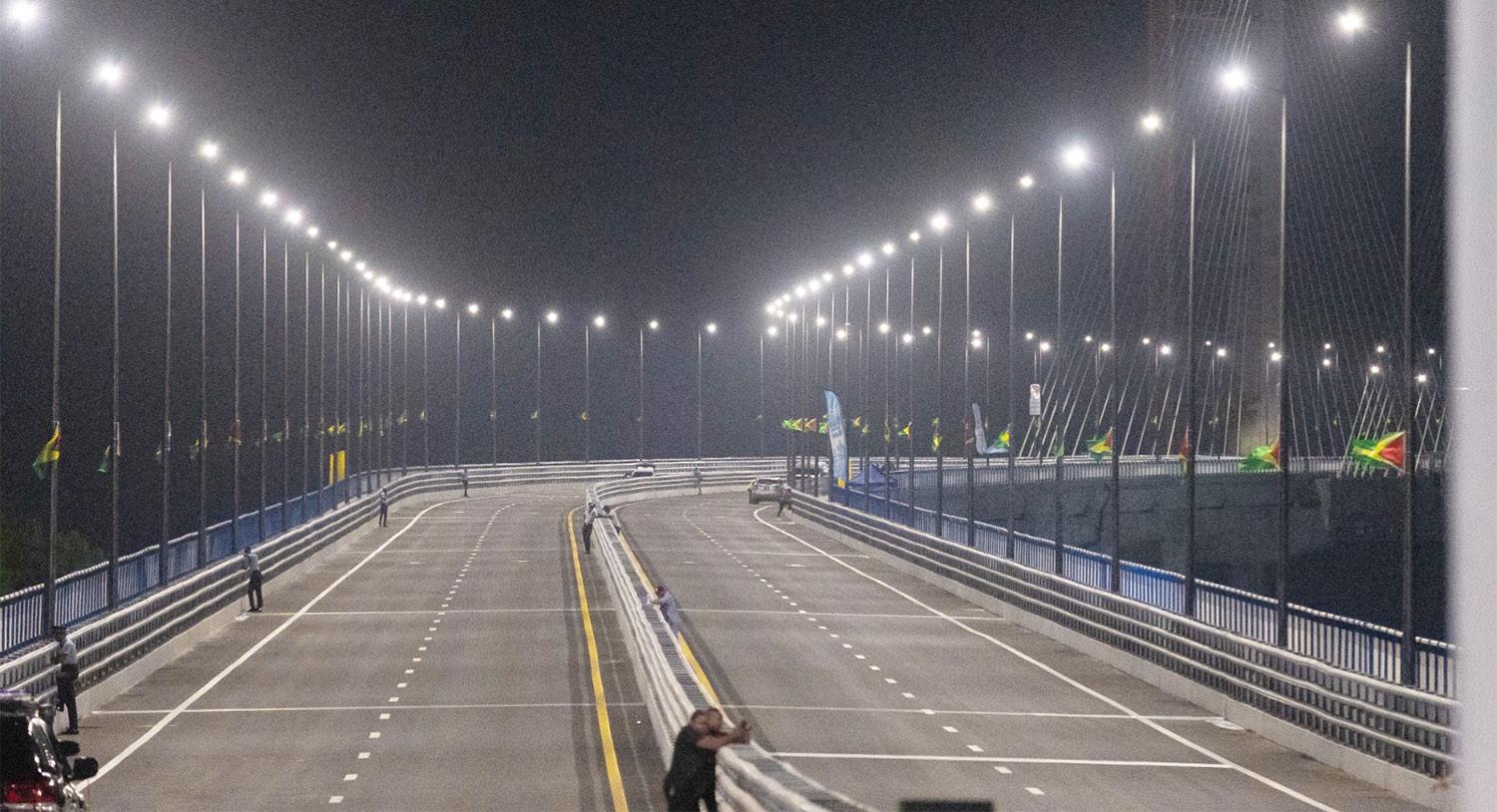
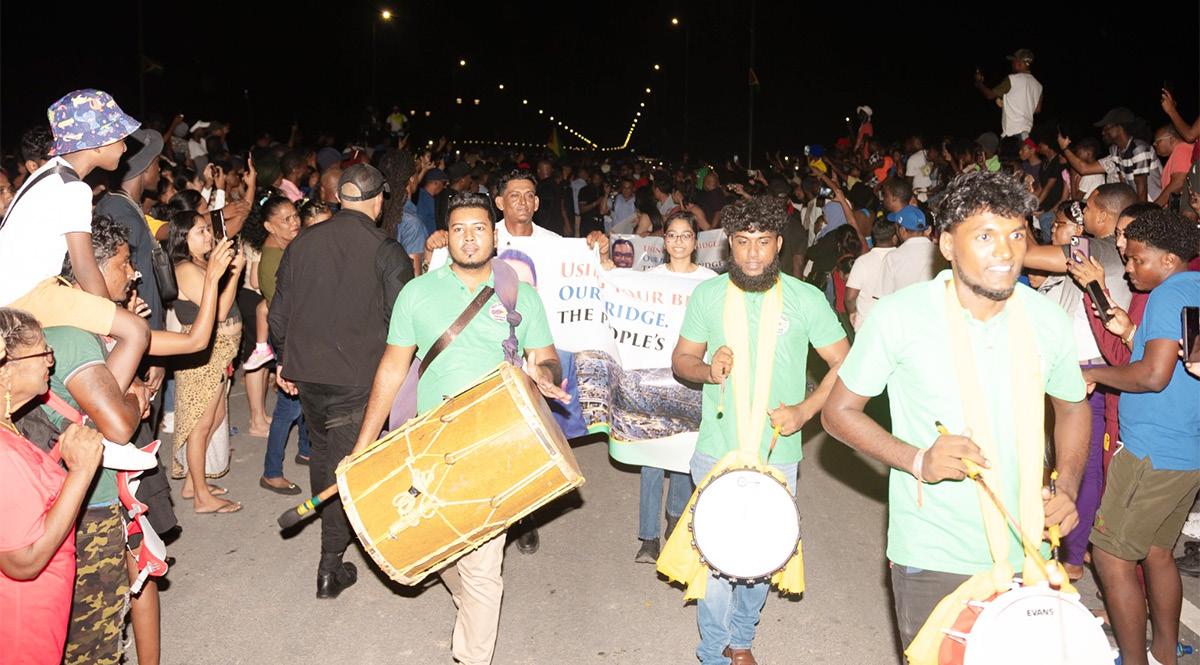

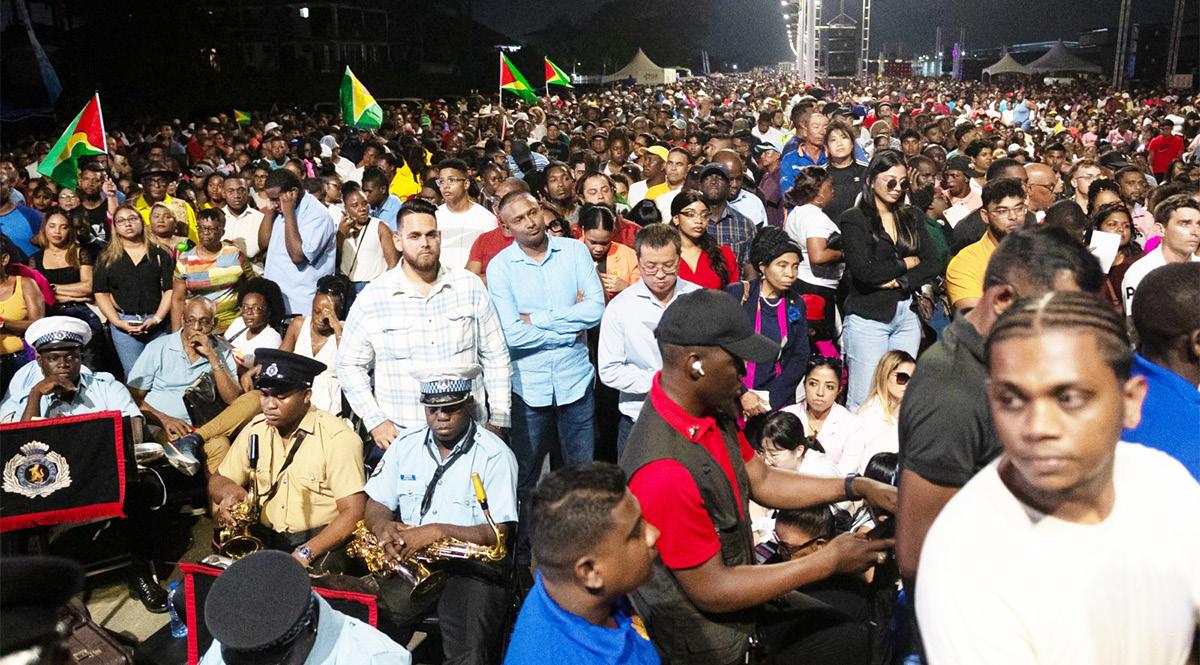
- President Ali says name honours a visionary leader, adviser, an anchor in Guyana’s development - calls structure ‘a catalyst’ for countrywide growth
By Naomi Parris
GUYANA’S largest and most advanced thoroughfare to date was officially commissioned on Sunday and named in honour of former President and current Vice-President Dr. Bharrat Jagdeo.
The official name, the Bharrat Jagdeo Demerara River Bridge, was announced by President Dr. Irfaan Ali as he addressed a large gathering at a ceremony held on the eastern end of the bridge.
In his remarks, President Ali paid tribute to Dr. Jagdeo, describing him as a confidant, a visionary leader, and a tireless champion for democracy, sustainable development, and global climate action.
Highlighting Dr. Jagdeo’s contributions to national development, the
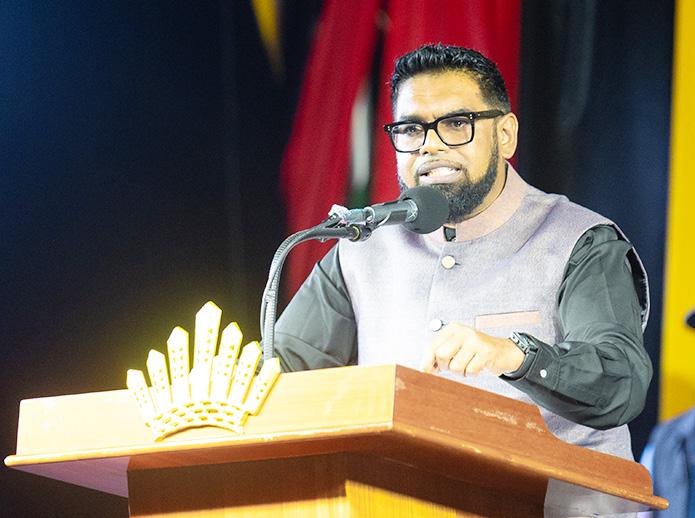
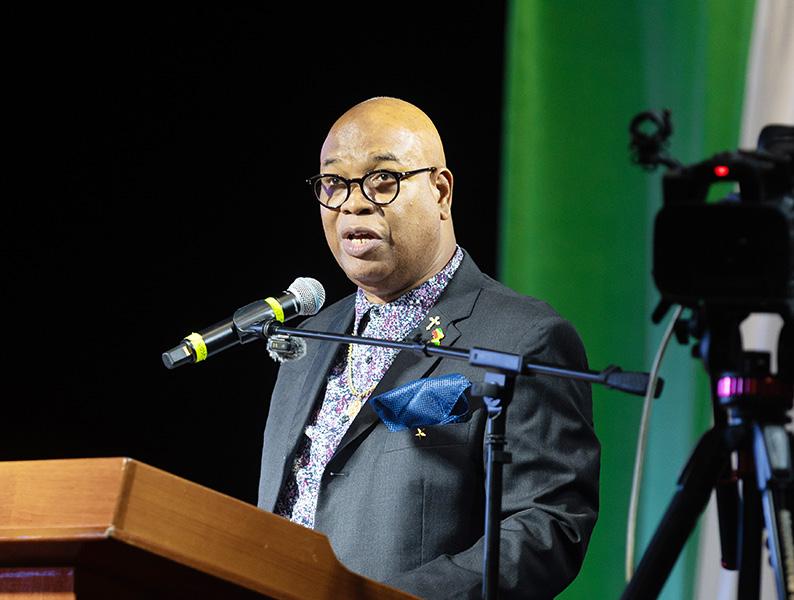

Guyanese leader praised his leadership during his tenure as President of Guyana, a period in which the country saw the restoration of macroeconomic stability, debt relief through the Heavily Indebted Poor Countries (HIPC) initiative, and a renewed focus on poverty reduction and infrastructure development.
President Ali noted that naming the bridge after Dr. Jagdeo was a fitting recognition of his decades-long service to the nation, and his enduring commitment to advancing Guyana’s socio-economic progress.
“I want to recognise a man that has dedicated his life to the upliftment of this country; a man who has been
The massive infrastructure, President Ali noted, will serve not simply as a crossing but a catalyst that will spur growth across the country.
Describing it as a ‘coming of age’ into Guyana’s rising development, the new four-lane bridge will serve thousands of commuters, who will now travel uninterrupted, eliminating the long
like this; projects that deliver benefits to every Guyanese,” the President said, adding:
“This bridge is proof that our resources are not squandered; they are reinvested into the long future of the people of our country. And so, my brothers and sisters, this bridge is your gift.”
The US$262 million structure which connects Regions Three (Essequibo

an adviser, an architect, and an anchor in our development today. I want to pay tribute to a giant of our local politics and economy,” the President said, noting that in the near future, many of the country’s giants will be honoured.
‘THE DAWN OF TRANSFORMATION’
wait times and bottlenecks that once plagued commuters using the aged Demerara Harbour Bridge.
“Let us remember that this bridge is financed not by chance, but by deliberate reinvestment of our natural resources… Oil revenues wisely managed are being converted into structures
Islands-West Demerara) and Four (Demerara-Mahaica), according to President Ali, reflects a nation rising.
“We are not teetering at the edges of development; we're reshaping the nation's destiny with each bridge, each road, each school, and hospital. We are weaving together the fabric of a modern
Guyana, and the fabric will be unbreakable,” he said.
The President stressed that the new bridge symbolises Guyana's transformation and readiness for the 21st Century.
The new thoroughfare, he added, marks only the beginning of several other massive projects aimed at easing traffic congestion and spurring growth in industrialisation, modernisation, and other investments.
‘CENTURY OF SERVICE’
Meanwhile, Public Works Minister Bishop Juan Edghill, in his remarks, said the project reflects a story of resilience, patience, quiet endurance, and shared purpose.
Standing as more than just a magnificent structure, the New Demerara Bridge is a bold, decisive vision, Edghill stressed.
“To the families who reshaped their days around construction, who endured the dust and disruption, thank you! To those who gave up their entire homes for this great case, I say thank you! Your patience and partnership built the foundation of this bridge,” the minister said to the mammoth gathering.
The bridge, engineered for a century of service, features four vehicular lanes, wide shoulders, and dedicated cycle and walkway lanes. Its foundations include 658 piles driven 400 feet deep into the riverbed.
It is a high-span, cable-stayed structure spanning 2,798 meters, with a
570-meter main span.
The project adheres to strict international best practices, with materials tested to the highest standards, and processes meeting ISO benchmarks.
“This engineering masterpiece is not only a marvel of design and durability, but also a symbol of progress, precision, and partnership. It stands as a proud testament to what can be achieved when visionary leadership, discipline, execution, and global collaboration meet,” the Public Works Minister added.
Meanwhile, China’s Ambassador to Guyana, Yang Yang hailed the project as a milestone of regional significance. She emphasised the bridge’s symbolic value not only as an engineering achievement, but as a catalyst for connectivity and economic growth across the region.
She also highlighted the collaborative spirit of the project, calling it a model of responsible international cooperation.
“Undoubtedly, this project is not only a bridge of steel and stone, but also a bridge of friendship between China and Guyana; a milestone in the high-quality Belt and Road cooperation we are building together,” Ambassador Yang said.
The project was undertaken by China Railway Construction Corporation International Limited, and was supervised by Politecnica.
HUNDREDS of trekkers stranded by blizzard near the eastern face of Mount Everest in Tibet had been guided to safety by rescuers, Chinese state media reported on Sunday, as unusually heavy snow and rainfall pummelled the Himalayas.
As of Sunday, 350 trekkers had reached the small township of Qudang, while contact with the remaining 200plus trekkers had been made, CCTV reported.
Visitors to the remote valley of Karma, which leads to the eastern Kangshung face of Everest, were in the
hundreds this week, taking advantage of an eight-day National Day holiday in China.
"It was so wet and cold in the mountains, and hypothermia was a real risk," said Chen Geshuang, who was part of an 18-strong trekking team who made it to Qudang.
"The weather this year is not normal. The guide said he had never encountered such weather in October. And it happened all too suddenly," Chen told Reuters.
Snowfall in the valley, which lies at an

The summit of the world’s highest mountain Mount Everest, also known as Qomolangma, is covered in cloud on May 8, 2008 (REUTERS/David Gray)
elevation averaging 4,200 metres (13,800 feet), began on Friday evening and persisted throughout Saturday.

The remaining trekkers will arrive in Qudang in stages
under the guidance and assistance of rescuers organised by the local government, CCTV reported.
Chen's party descended from the mountains on Sunday

and was greeted by villagers after enduring a harrowing evening of heavy snowfall combined with thunder and lightning. With tears in her eyes, Chen accepted their offers of sweet tea and the promise of warmth, she said.
"Back in the village, we had a meal and were finally warm."
Hundreds of local villagers and rescue teams had been deployed to help remove snow blocking access to the area, where nearly 1,000 people had been trapped, according to an earlier report by statebacked Jimu News.
The CCTV report did not say if local guides and support staff of the trekking parties had been accounted for. It was also unclear if trekkers near the north face of Everest, also in Tibet, had been affected or not.
The north face of Everest, due to its easy
access by paved road, regularly draws large numbers of tourists. October is a peak season, when skies usually clear at the end of the Indian monsoon.
Ticket sales and entry to the entire Everest Scenic Area were suspended from late Saturday, according to notices on the official WeChat accounts of the local Tingri County Tourism Company.
To the south of Tibet in Nepal, heavy rains triggered landslides and flash floods that have blocked roads, washed away bridges and killed at least 47 people since Friday.
Thirty-five people died in separate landslides in the eastern Ilam district bordering India. Nine people were reported missing after being swept away by floodwaters and three others were killed in lightning strikes elsewhere in the country. (Reuters)

RANKS from the Guyana Police Force (GPF) and the Guyana Geology and Mines Commission (GGMC) are investigating two distinct but related incidents arising from a land-mining dispute in the Toroparo area, Region #7, which occurred on September 23 and September 30, 2025.

The initial altercation on 2025-09-23, captured on video and featuring the voice of Mitchell Watson, involved personnel affiliated with miner Ronaldo Alphonso and a group comprising rangers Marvis Hillman and Edson Carter. This encounter is reported to have escalated to the alleged discharge of
firearms by Alphonso's security team.
A subsequent incident one week later (2025-09-30), also documented on video, featured security agent Leon Wilkinson as the primary speaker, Edson Carter, Ranger, and security Randy Allen speaking with Juleth George (GM Alphonso Mining) and operator


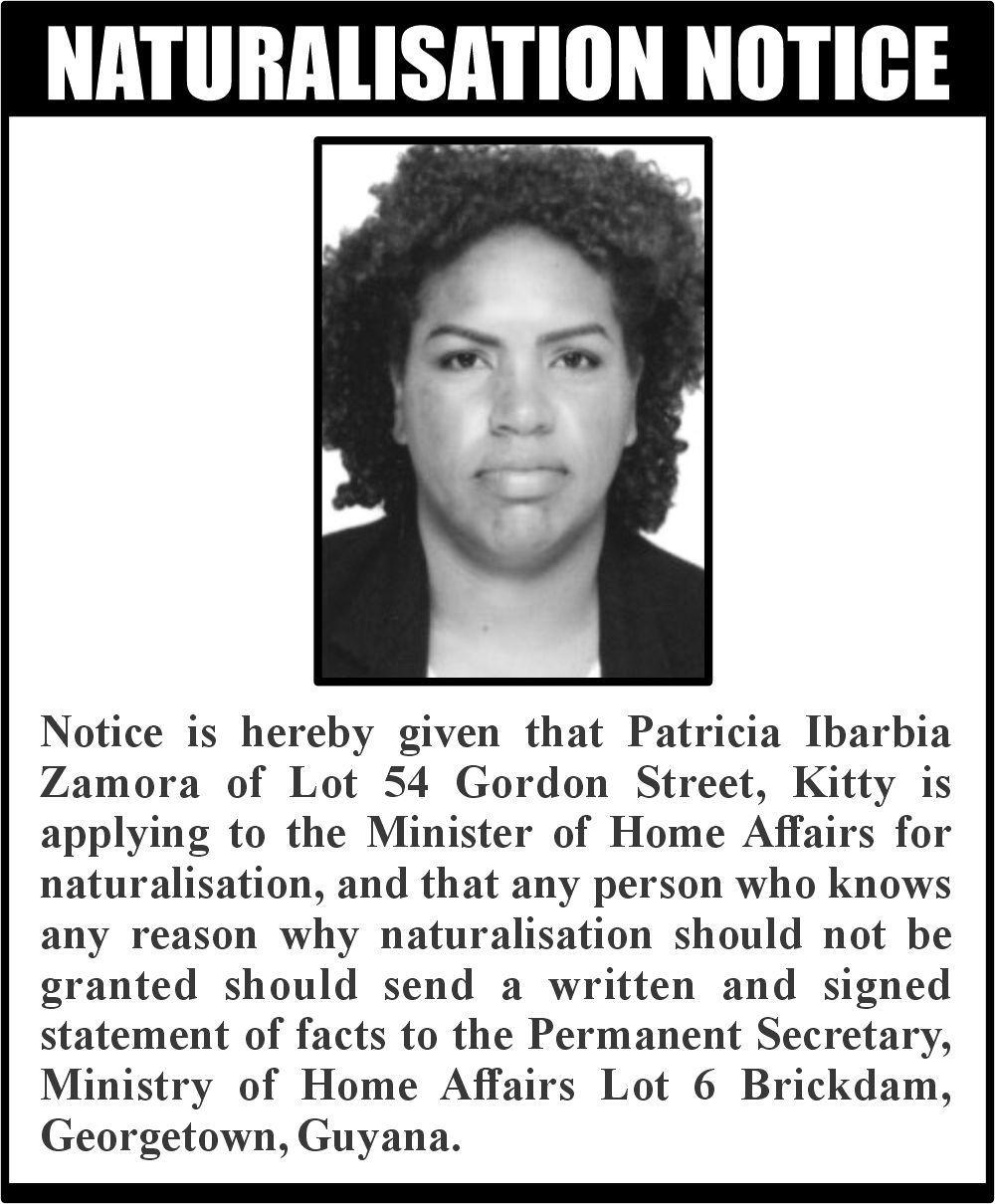
William Hill, indicating a continuation of the unresolved tensions between the involved parties.
In response to both incidents, Guyana Police Force ranks from Region #7 initiated in-
vestigations. The response included the arrest of all involved individuals, and the seizure of relevant firearms.
To mitigate further conflict and ensure order, a joint operational team consisting of police led by an inspector and police ranks, and officers from the Guyana Geology and Mines Commission is on the location monitoring the situation. (GPF)



THE commissioning of the US$262 million Bharrat Jagdeo Demerara River Bridge reflects the vision that has driven Guyana from economic recovery to significant prosperity.
President, Dr Irfaan Ali's choice to name this impressive structure after Vice-President Dr Bharrat Jagdeo goes beyond a mere ceremony. It acknowledges the person responsible for Guyana's modern development
journey.
This bridge is a tangible result of the strategic governance that began during Dr Jagdeo's presidency. Under his leadership, Guyana moved from years of economic stagnation to five straight years of strong growth. His administration nearly cut external debt in half and tripled reserves, laying the groundwork for today's oil boom, which is expected to generate significant revenues for
Guyana.
The smooth shift from recovery to transformation shows the ongoing vision shared between Jagdeo's foundational work and Ali's current accomplishments.
President Ali's statement that this infrastructure "signals that Guyana is ready to industrialise, modernise, and claim its space in the 21st century" aligns with the reinvestment approach that began during Jagdeo's time.
The bridge operates toll-free and is accessible 24/7. It will save commuters GY$3.5 billion annually, illustrating how oil revenues are turned into lasting benefits for all Guyanese.
This method reflects Jagdeo's foc us on inclusive growth and sustainable economic change.
The timing of this commissioning, as Guyana continues to be the world’s fastest-growing economy with a 44 per cent GDP
growth in 2024, underscores the long-term planning that marked Jagdeo's leadership. His commitment to investments in social services, housing, and transport infrastructure created the framework that allows today's government to effectively manage oil wealth.
By naming this important bridge after Jagdeo, President Ali has established a lasting symbol of how visionary leadership can connect different peri-
ods of development.
The bridge links not only the east and west banks of the Demerara River, but also Guyana's past successes with its vast future potential.
This bridge will stand for a century as a testament to the lasting impact of leaders who recognise that true development needs both immediate support for citizens and long-term investments in national progress.

I NOTE with interest a report in sections of the media that Policy Forum Guyana (PFG)—a registered non-profit organisation—has protested that it is being sidelined by the Government of Guyana (GoG).
Let me state unequivocally: this is a step in the right direction, and I commend the government for taking it.
The so-called NGO in question, established around 2015, has consistently operated as a political extension
of APNU. If we are truly committed to transparency and accountability, then we must apply the same standards to these organisations that they so often demand of others.
The government ought not to continue engaging with NGOs that are themselves non-compliant. They must adhere to basic governance principles.
Their bylaws must be publicly accessible, annual reports must be published consistently, annual general meetings (AGMs) must be

held in accordance with their bylaws and who are their Board Members? There is no such information on their website as to the governance structure, its members and board members. These are basic requirements to meet the bare minimum transparency thresholds that are evidently absent. Failure to comply with their own rules—and more importantly, with the legislative and regulatory framework under which they operate—must be met with appropriate penalties. Gov-
ernance is not optional. It is a legal and ethical obligation.
Many of these entities are quick to criticise the Private Sector Commission (PSC), yet the PSC exemplifies transparent and accountable governance. It holds regular AGMs and publishes its annual reports without fail.
It is time for the relevant authorities, particularly the oversight bodies, to take decisive action.
They must enforce compliance, demand transparency, and hold these NGOs accountable under the law.
Political masquerading under the guise of civil society must no longer be tolerated. The integrity of our democratic institutions depends on it.
Many of these NGOs—if not most—operate under the guise of nonprofit status while failing to uphold the very principles they claim to champion. They solicit donor funding for projects, pay themselves inflated salaries, and exploit tax exemptions, all while delivering little to no meaningful outcomes. This is not just unethical; it
is a betrayal of public trust and donor confidence. It is time to call out these sham organizations for what they are. We must demand full transparency, enforce accountability, and uphold ethical governance across the nonprofit sector. The days of hiding behind the nonprofit label while engaging in opaque and self-serving practices must come to an end.
Yours sincerely, Joel Bhagwandin
By Dr Amit Telang, MD
THIS week witnessed two interrelated and interesting developments in Georgetown, igniting, once again an oft repeated debate on health, nutrition and lifestyle. On one hand, a US fast-food chain, Wendy’s, became the latest entrant to Georgetown’s fast-evolving and vibrant food scene, and on the other hand, Govinda’s, a pure vegetarian restaurant opened its doors to patrons, offering a high-taste experience with a theme, ‘Food not only for the body but also for the soul’.
The debate, especially on the social media, certainly makes one wonder whether Guyana, like many other developing countries, would now experience a phenomenal transformation in diseases too?
Development invariably means lifestyle modifications, and such changes often tend to portend a dangerous trap of increasing disease burden and concomitant government spending.
Before entering the critical realm of correlation between development and disease, we need to encourage an informed debate on this topic. It is imperative, since we often approach this topic through a simplistic paradigm that development automatically means well-being. Poverty and disease, in our mindsets, traditionally co-existed, and the combination is so obvious that we tend to believe that development would automatically mean freedom from disease. Many developed countries have proven this paradigm to be completely wrong.
This brings us back to the now accepted correlation between the pace of development and emergence of certain disease
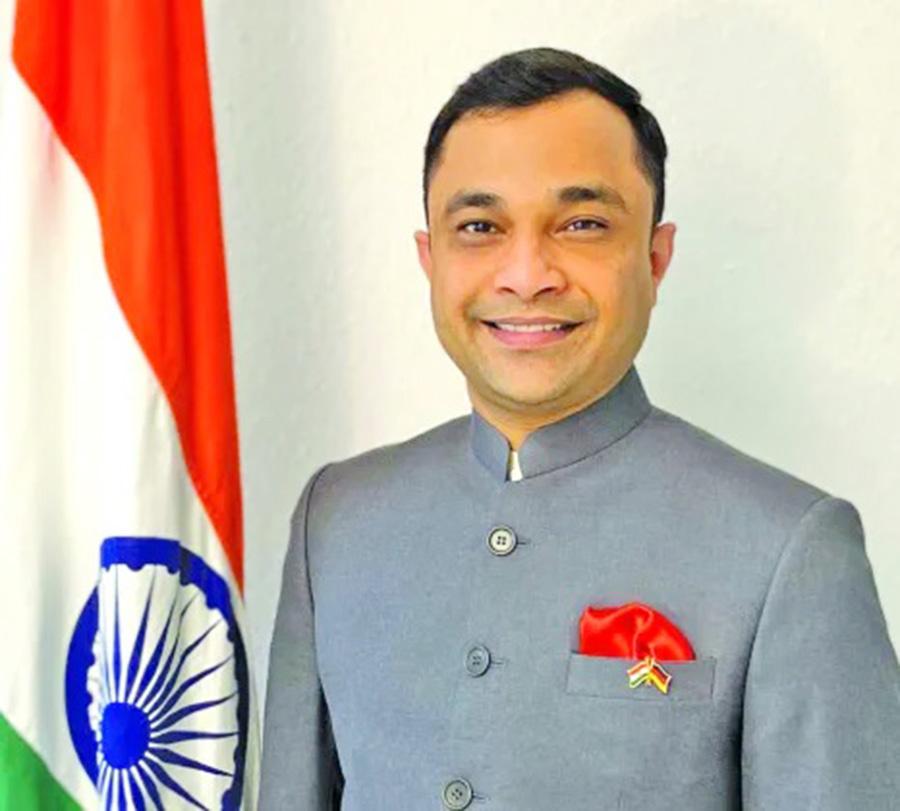
patterns. Even in the most developed economies, it is often the poorest who tend to catch such diseases predominantly due to their uninformed if not poor food choices. It doesn’t mean that executives and professionals do not succumb to the temptation of fast and comforting food preferences. A tired individual looking at something that would bring instant satiety invariably chooses a fast-food option. Such ‘comfort food’ culture perpetuates on the premise that the food must ensure instant satiety (now proven as sugar or dopamine surge) allowing an individual to feel re-energised enabling quick return to the usual chores. Depression and self-image, too, play a role, but that is an entirely different topic deserving separate discussion. Food today has unfortunately become as much about display of affluence, peer pressure and prejudice as it is about ‘satiety’. Food has graduated from being a source of nutrition to a symbol of prestige and prominence. It would be inappropriate to malign any cuisine or dietary choice per se by boxing it into ‘healthy’ or ‘unhealthy’ category. Every cuisine offers healthy and unhealthy choices. It has an inescapable link
evolved over centuries, based on a multiplicity of factors. We must appreciate that like any other country, Guyana too has a complex genetic make-up and people’s food preferences have evolved out of ethnic influence, cultural practices and economic disparities. Societal pressure about physical appearance and tropes of perceived affluence tend to affect food preferences.
approach to health and nutrition as a holistic discipline- going beyond tertiary healthcare. It is an immediate necessity because in all likelihood, it would determine the future of the next generation.
with culture and an unavoidable link with perceptions regarding development and progressive lifestyle.
The definition of ‘healthy’ and ‘unhealthy’ depends not only upon body constitution, genetic make-up and local food availability, but also what people around you perceive as healthy or unhealthy. There lies the real challenge. A diet classified as healthy for one individual of a certain genetic make-up, gender and lifestyle might be the unhealthiest choice for another individual. Yet, people tend to generalise based on public perception. We seldom pay enough attention to inherent differences in body-type and genetics as well as individual choices.
Alongside prevalent stereotypes regarding physical appearances, food preferences have emerged as a scale of measuring development and upward mobility. To complicate it further, a rampant diet culture and absurd calorific choices overlooking the necessity of a balanced diet pose a serious lifestyle challenge even in the most developed societies.
Guyana is a multiethnic society. It is also a rapidly developing economy. Guyana’s food culture has
Physical parameter need not be overlooked but they should not be to the detriment of overall health and well-being. Such superimposed food preferences endanger the young and working population and push them towards a deadly trap of development induced diseases.
Is it avoidable? The answer is definitely, and fortunately, yes. But it requires concerted efforts and a well-researched healthcare policy, extending beyond the realm of curative and therapeutic approach to disease.
Lifestyle modifications are mandatory to diffuse this ticking timebomb, but societal awareness is the real key to success. It is necessary to pay attention to this discipline, lest it might affect the future of a country poised to become the fastest growing economy. Development should not come at the cost of a humongous disease burden.
It will require considerable effort and commensurate resource allocation to address this challenge. Guyana is well placed not only to address the challenge but to emerge as a shining model to be emulated. It would, however, require an informed debate. There is a need to graduate from simplistic classification of food or body types into good or bad, healthy and unhealthy, obese or slim, vegetarian or non-vegetarian. The subject demands a carefully crafted
Our leaders and healthcare professionals have a responsibility to lead the charge. They can influence and motivate the nation, especially the young generation. In India, for example, Prime Minister Narendra Modi unveiled his LIFE or Lifestyle for Environment initiative keeping in mind the need to create awareness about holistic health and wellness, especially among the youth, but also among the middle-aged professionals.
Fitness doesn’t necessarily mean being physically attractive, especially if attention is paid to mere physical appearance with complete disregard for the need for a balanced and nutritious diet along with mental well-being.
Holistic health must guide our food and life choices, where overall health is equally if not more important than mere physical attributes. PM Modi’s emphasis on Yoga and Ayurveda is not an exercise directed towards promoting Indian culture or food practices. It is about sharing the traditional wisdom where body and soul are in unison- in a state of perfect balance. A body and mind in complete harmony would more likely transform into a harmonious society, at ease with itself.
In recent years, Yoga and Ayurveda have gained universal attention. People might have some reservations about Ayurvedaas they tend to connect it with strict dietary practices and even religion, but, across various cultures and nationalities, traditional medicinal systems are increasingly acquiring prominence and recogni-
tion. Ayurveda is one of them. These medicinal systems have been critical in preserving age-old wisdom that our ancestors and indigenous people painstakingly preserved and perfected over the centuries. Today, even Western scholars conclusively accept their obvious health benefits. The gold standard is preferring local over externally superimposed choices.
Even leading universities in the West, like Stanford, are devoting significant attention and resources to salience of nutrition and its impact on immunomodulation in disease prevention and holistic health. Local produce that harmonizes local food with local genetic make-up and prevalent cultural practices including food preparation are increasingly accepted as better for overall health compared to externally superimposed dietary habits. Traditional medicine and lifestyle modifications contribute towards achieving this goal.
Appreciating the importance of traditional medicinal systems and lifestyle modifications, the Government of India created a Department of AYUSH dedicated to undertaking research and evolve specific protocols for practical applications. India is open and committed to sharing this knowledge with our partners.
Our traditional medicinal systems and know-how that our ancestors and indigenous people preserved as conventional wisdom need mainstreaming and widespread recognition. It is not a burden or quackery; it is a valuable resource. Our collective heritage. It is a heritage of the entire humanity. A treasure inherited from our ancestry to be preserved and transferred to the posterity.
Dear Editor,
I READ with interest the letter published on October 3, 2025, captioned, “Measures announced by the President will do nothing to ease the pressure on the Guyana dollar.” As a student of international finance currently serving my country abroad, I noted with particular attention the comments attributed to Dr Terrence Campbell regarding foreign-exchange interventions and broader economic management.
For any national debate on such critical matters to be meaningful, it must rest on evidence rather than conjecture. In that spirit, I wish to respectfully clarify a number of inaccuracies in Dr Campbell’s assertions.
First, the claim that
the Bank of Guyana’s foreign-exchange interventions signal “malignant” economic mismanagement is both inaccurate and misplaced. Central Bank interventions are standard policy tools used globally to smooth short-term volatility and ensure exchange-rate stability—particularly in rapidly expanding economies such as Guyana’s. The scale of intervention today reflects not weakness, but the extraordinary expansion of trade, investment, and capital flows.
In 2020, Guyana’s economy was valued at approximately US$5 billion. By 2024, it had grown fivefold to US$25 billion and is projected to reach US$28 billion by the end of 2025. With such unprecedented expansion, it is entirely logical that the volume of
foreign currency entering the market would increase proportionately. That is why it is difficult to comprehend why these assumptions are being made by Dr Campbell that attempt to make out the situation as some sort of mini-apocalyptic occurrence. These interventions are possible precisely because of prudent fiscal management and strengthened reserves. These interventions are deliberate action following a tried and tested model.
Moreover, His Excellency President Irfaan Ali has not acted unilaterally, but has convened a team of experts and financial leaders to develop a structured response. The introduction of nine new policy measures aims to strengthen Guyana’s financial system, expand access, and enhance over-
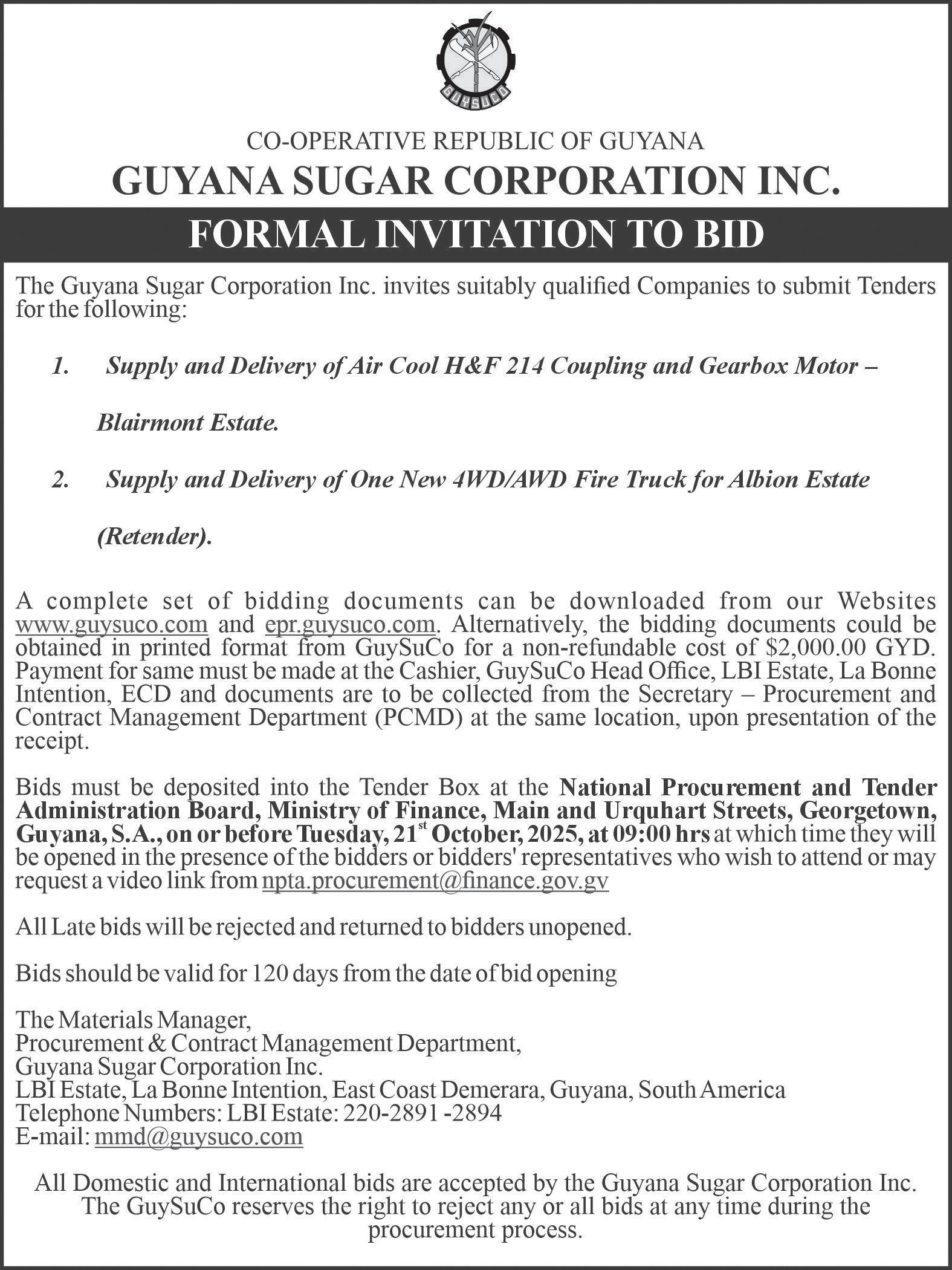
sight to ensure fairness and transparency in the foreign exchange market. Notably, these measures were well received by the banking community, reflecting their alignment with sound financial practice.
Second, the characterisation of government spending as “reckless” or focused on “poor quality infrastructure” overlooks the transformational development underway across the country. Investments in farm-to-market roads, bridges, housing, schools, hospitals, and other public infrastructure are central to the government’s clearly articulated national development plan.
One only had to listen to Dr Bharat Jagdeo outline the strategy a week ago in a clear manner. Institutions such as the Inter-American Development Bank and the Caribbean Development Bank have repeatedly endorsed Guyana’s development drive as essential for long-term competitiveness and sustainable development.
The International Monetary Fund (IMF) itself, in its most recent Executive Board report, commended the Guyanese authorities’ commitment to balancing development needs with prudent macroeconomic
and fiscal policies. This evidence speaks for itself.
Third, the assertion that government policy neglects the non-oil economy is contradicted by the data. Nonoil GDP continues to record double-digit growth—13 per cent in 2024—driven by agriculture, construction, ICT, and services. Targeted investments in agro-processing, aquaculture, forestry, and tourism are expanding Guyana’s export base and diversifying the economy. The evidence points to deliberate and balanced diversification initiatives in the economy.
On the issue of gold smuggling, this is indeed a challenge faced by many gold-producing countries. However, here in Guyana, it is being addressed through stronger regulatory oversight, tightened licensing for traders and centralised monitoring via the Guyana Gold Board. Inter-agency coordination and the introduction of technology-driven tracking systems are enhancing transparency and enforcement. While these reforms take time to yield full results, progress is visible and measurable. To allege government complicity without substantiation is both unfair and counterproductive to the collective national effort to curb illicit activities.
Finally, Guyana remains fully compliant with international financial standards, including the Financial Action Task Force’s (FATF) 40 Recommendations. Our continued removal from both FATF’s “grey” and “black” lists is a significant national achievement, made possible through strong institutional reforms led by the Attorney General, the Honourable Anil Nandlall, S.C., and his dedicated team. To suggest a return to the failed policies of the 1970s and 1980s is baseless alarmism that does not reflect the current strength of Guyana’s macroeconomic fundamentals or its robust fiscal discipline.
Constructive criticism is essential in any democracy and should always be welcomed. However, it must be rooted in fact and driven by the shared goal of national progress. To dismiss evidence-based policy measures while offering no credible alternatives contributes little to informed public discourse. Guyana deserves a higher level of debate—one that lifts the national conversation above partisanship and towards collective problem-solving. Yours faithfully, Sasenarine Singh
Dear Editor,
THIRTY-THREE years ago, violence engulfed the streets of Georgetown to derail the democratic gears in motion, after 28 years of undemocratic PNC rule.
The organised violence and inflammatory state media coverage ultimately failed to stop Guyana's first free-andfair election since 1964.
But politics is cyclical in Guyana. The 2020 elections saw attempts by the Granger-led government to barefacedly
rig the elections and undermine the will of the people once more.
Anyone genuinely concerned about free speech, victimisation and upholding Cheddi Jagan's legacy would've been defined by their voices in 2020. The rigging attempt failed - and today those involved sit on the executives of the PNC, AFC, WPA, WIN and FGM.
Similarly, in 2025, there was a coordinated misinformation campaign intended to derail the elections. This was led by elements in APNU, WIN
and FGM and failed once more.
“The struggle will be long and hard. Sacrifices, there will be many. But time and history are on our side and win we shall. We have been vindicated and the results of the October 5th elections prove that victory was inevitable.”
Democracy liveth. Cheddi Jagan's legacy liveth.
The People of Guyana liveth.
Yours faithfully, Nikhil Sankar
THE AFC is gone. The AFC will be alive in 2027. Nigel Hughes is gone for sure, and I doubt his wife Cathy Hughes will stay on in the party without him. Kemraj Ramjattan said to Leonard Craig in June that he has generally gone from politics. Raphael Trotman is not in the best of health. I don’t think David Patterson all by himself will get enough traction from the Mulatto/ Creole class (MCC) to help him.
Intellectuals, political society and the general Guyanese population do not fully grasp the psychic value the MCC attaches to colour. I have seen this attachment as a Guyanese social activist and as an academic that uses class analysis for “donkey years” now. For some esoteric reason, the MCC at a deep Freudian level accepts light complexion as anthropological reality.
Patterson is too dark skinned to find embrace by the MCC. Of course, you can argue that Cathy and Nigel Hughes were darker rather than brown, but the
Hughes came from within the bowels of quintessential middle-class aristocracy where status and wealth met in a formidable confluence. Cathy Hughes’s father was one of the darkest Guyanese I have seen but he was seen as part of the crème de la crème of the MCC.
Patterson will hold on as leader but as the barren, hopeless environment closes in and as the water trough dries up, the AFC will simply move off the scene maybe even before 2026 ends. The enemy of the AFC in 2026 will be young people who will not gravitate to it because they believe that the AFC is gone.
For a party that was in power for five years, and this was just recently (2015-2020), it couldn’t get even 4,000 votes. And look at the names – Nigel Hughes, Kemraj Ramjattan, Raphael Trotman, Cathy Hughes, David Patterson. Forward Guyana got a seat in parliament with Amanza Walton-Desir being nationally known but not as prominent as the entrenched named above.
I would like to think from 2015, after the AFC secured state power, when I began to dissect their politics and the personalities of the AFC leaders, I would have gone over the 100 mark of columns on everything about the AFC and their leaders, so I will not pen any further words on that subject.
I can’t say that I will not welcome the death of the AFC. On a personal level (which I would love to expand on, but you know how people feel about being personal) and political level, I think the AFC was a terribly un-philosophical, un-historical, anti-progressive, anti-humane organism that philosophically should have lost its existence ten years ago. In my analysis it is the least redeemable party since the 1950s onwards to have entered government.
I am glad they will die a natural death. I am glad we will not see some of them ever in politics again. My particular dislike is for Cathy Hughes. My soul is still riveted by what she did former AFC executive and


her comrade, Trevor Williams. Humans just do not do what Williams accused Hughes of doing.
I leave a song for Cathy Hughes which tells the story of how pompous and haughty the human can be. This is one of the most philosophical pop songs ever composed and sang. I liked it when I first heard it on the morning radio programme with Ron Robinson.
“Stairway to Heaven” points us to an alternative life of giving and loving and peace if only we can see that it is an alternative to the elitist, snobbish life we live. Strangely, for reason I would never know, though I love the original version by Led Zeppelin, my favourite version is by
an unknown reggae artiste named Ed Robinson. His version is a fine display of reggae rhythms.
Stairway to Heaven by Led Zeppelin
There's a lady who's sure all that glitters is gold
And she's buying a stairway to heaven
When she gets there she knows, if the stores are all closed
With a word she can get what she came for
And she's buying a stairway to heaven
There's a sign on the wall, but she wants to be sure
'Cause you know sometimes words have two meanings
In a tree by the brook, there's a songbird who sings
Sometimes all of our
thoughts are misgiven
Dear lady, can you hear the wind blow? And did you know
Your stairway lies on the whispering wind?
And as we wind on down the road
Our shadows taller than our soul
There walks a lady we all know
Who shines white light and wants to show
How everything still turns to gold
DISCLAIMER: The views and opinions expressed in this column are solely those of the author and do not necessarily reflect the official policy or position of the Guyana National Newspapers Limited.
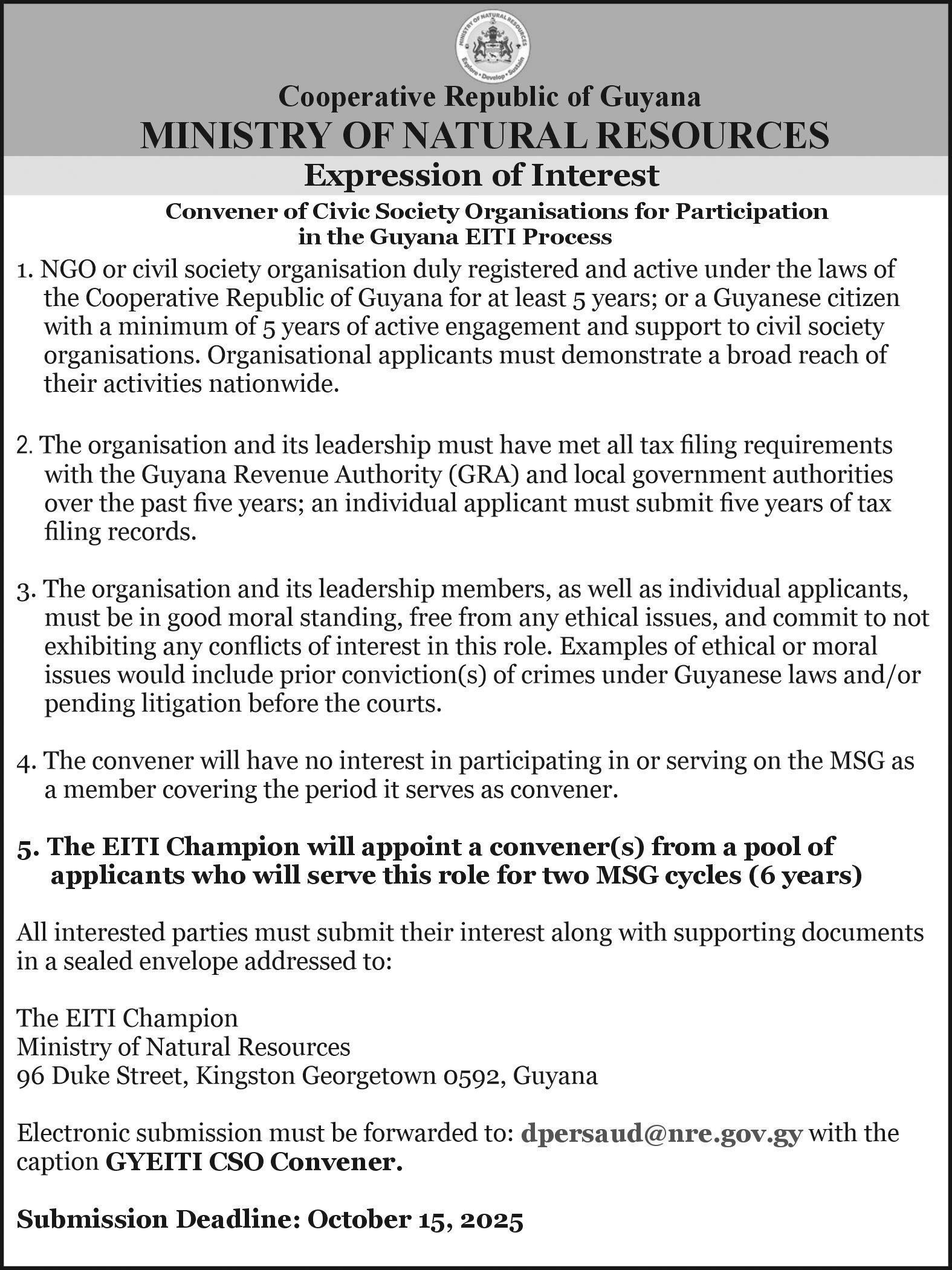
Do young people know what a typical election was like before October 5, 1992?
THIS article was actually written on October 5, a day that stands as a landmark in the political and electoral history of Guyana. Of course, elections which were due in 1990 were postponed by two years to accommodate certain Carter Center-brokered reforms that brought about free and fair elections. To appreciate the significance of October 5, it is important to understand what was happening in our politics and electoral landscape prior to October 5, 1992.
Visualise a system where every GECOM chairman is unilaterally appointed by the President and the President chose one of his loyalists. GECOM commissioners are appointed for three months before and three months after the elections and then dissolved. Imagine that management of elections was an actual ministerial portfolio. Picture a situation where most of the permanent and elections day staff of GECOM were either hired at Office of the President and sent to GECOM or personal aides of ministers and other
high government officials were part of GECOM elections day staff. Consider an elections without observers of any stripe or size, except for government owned and appointed media houses.
Imagine that a day or two before elections you made sure to check that your name was on the official voters’ list, but when you turned up to your designated place of poll, which was heavily guarded by gun-slinging GDF officers, you were told you cannot vote because your name is not on the list. Or, picture that your


name was indeed on the list, you joined the long line to cast your ballot, but when you reached the front, and attempted to access the voting area, you found your name crossed out because you had already voted. While you were being turned away from voting, you saw a young, healthy person, next up to vote, loudly remonstrating because she was being told that there is a signed proxy form in her name and someone had already voted for her. Further, imagine you were assigned to work as a party agent at a particular polling place, and prior to the opening of poll, you witnessed the arrival of the ballot box, transported by a GDF truck, already containing dozens of ballots, but you were not allowed to verify the contents of the box before polling starts. Further, imagine that at some polling stations after marking your ballot for the party of your choice, you were required to hand it to the polling clerk to be placed in the ballot box on your behalf and you left the polling place not knowing for sure if that ballot paper made it into the box.
Try to picture that you see dozens of people casting their ballots, the elections officers refusing to put ink on their fingers and after casting your own ballot, you see those same persons in the line to vote again. Or visualise that, while in the line to vote, a bus load of persons who are complete strangers to your small, close-knitted community, arrive and were given priority to vote. After casting their ballots, they exited the polling station with all fingers uninked, rejoined the bus as a brigade and left. Imagine your entire family who were registered to, and has always voted at the primary school across the road, were told that they were listed to vote at another unfamiliar place 50 miles away. Further, just imagine that after the close of poll a GDF truck
arrived with gun-toting soldiers, heisted the ballot box and disappeared into the night.
Consider that at the place where you voted a few brave souls mounted a small protest to demand that their votes be counted at the polling place, and that military officers should not just take away the ballots to an unknown destination. And in response, GDF officers simply open fire, killed protestors and kept going with the ballot box.
Stretch your mind a bit more and envision that, by law, Guyanese who moved or were born to Guyanese parents overseas and located in the Commonwealth were allowed to vote. An overseas voters list is generated and almost 90 per cent of overseas ballots were casted. Then party agents, private investigators and news agencies made checks to verify the existence of the voters and found open playfields, uninhabited buildings, or family homes whose generational occupants have never heard of any of the dozens of persons listed at that singular address.
Imagine your party agents were only able to witness the counting of 10 per cent of the ballot boxes. For the remaining boxes, party agents were given a time and place for counting the ballots and upon arrival they were issued with a results sheet and told that they arrived late, and the ballots were already counted. What about if you saw ballot boxes that were removed, by the GDF, from polling stations in your district still loaded in parked trucks in the compound of a government building or the election agency, yet you hear results announced purporting to come from those untouched boxes.
Anyone born after 1975 would not have been eligible to vote till sometime after 1992. Therefore, if you were born in the late 70s and beyond, all that I related above will sound like make believe emanating from wild imagination. It may even feel as though you are immersed in a land of fantasy. This group
accounts for more than 75 per cent of our population. For the other 25 per cent and hundreds of thousands of other deceased Guyanese, the descriptions above were actual, lived experiences for elections between 1968 and 1985 (1968, 1973, 1980, 1985).
Many of our countrymen and women died never having the experience of free and fair elections in Guyana. That sacred right of having their votes counted was violently wrestled from them. Many have fought and struggled against the suppression and outright stealing of their free democratic will, but did not live long enough to witness or experience a free and fair electoral process.
October 5, 1992 marked the end of an era where someone sat in their bed chamber and decided what the results would be, and simply ordered elections officials to announce it, and in the process ignored the actual votes casted by hundreds of thousands of Guyanese.
The sacrifices of Dr Cheddi Jagan, though almost undone in 2020, along with a consortium of other Guyanese and international actors, should not be taken for granted.
This day must be commemorated in perpetuity as a memorial and a reminder of the consequences of electoral backsliding. Since 1992, several legal reforms have tightened the system in ways that enhanced transparency to the point where the just concluded 2025 General and Regional Elections were said to be the most transparent in our history. There are a few more reforms that are still possible. As a nation, we must diligently pursue every avenue for refinement of our electoral system and secure democracy for future generations.
DISCLAIMER: The views and opinions expressed in this column are solely those of the author and do not necessarily reflect the official policy or position of the Guyana National Newspapers Limited.
WITH continued expansion in Guyana’s maritime sector, Minister of Public Utilities and Aviation, Deodat Indar, has noted that activity has gone up by some 54 per cent since 2020 and is expected to climb even more.
The minister made these remarks during the recent commissioning of two pilot boats, during which he noted that in 2020, when the People’s Progressive Party/ Civic (PPP/C) took office, there were just about 2,037 ships coming into the Demerara River.
As of last year, he noted that this had increased to 3,144 ships, an addition of 1,107 that came over the five years.
“So, the level of activity over the five-year period has gone up by 54 per cent since 2020, and it's expected to climb as the economy grows,” he said.
To this end, he noted that as the country imports a lot of its consumables and building materials, which come through the waterways, the government has been working on continuous dredging of the main channel.
Meanwhile, he noted that they have also done something that was costing ship owners a lot in terms of insurance, which was removing wrecks from the river.
He disclosed that 17 major wrecks were removed, which were done through a tendering process to ensure that a competent company could have done the job well.
“The wrecks were there, and they were hazards to vessels coming in and going out,” he said.
As a result of that, he said that insurance for vessels entering the river was very high and that cost had impacted the cost for goods arriving in Guyana.
However, with the 17 wrecks removed, that is no longer a problem and also, it will aid in the expansion of maritime traffic.

AS the Guyana Government continues to push towards digitisation in several sectors, the country’s immigration support services has moved to a new digitised system.
This was announced by the Ministry of Home Affairs on Sunday in an urgent public notice in which it noted that “The Immigration support services is transitioning to a new, completely digitised system.”
This took effect on Sunday and the existing website,
eservices.iss.gov.gy was expected to be down temporarily.
In the notice, it said that applications that were submitted prior to Sunday will still be processed, even as it was noted that in-person applications are still being accepted at the ministry’s Brickdam office.
Just a few weeks ago, President Dr Irfaan Ali had said that the government is aiming to enhance the experience of persons coming into Guyana and move towards

digitisation.
At that time, he noted that the country must be compliant with international standards from a technological and security standpoint.
As part of this transformation, in January of this year, the border control and e-gate system went live. This was followed by the E-passport issuance system going live the following month.
This, it was noted, has resulted in improved security, accuracy and reliability using technology.
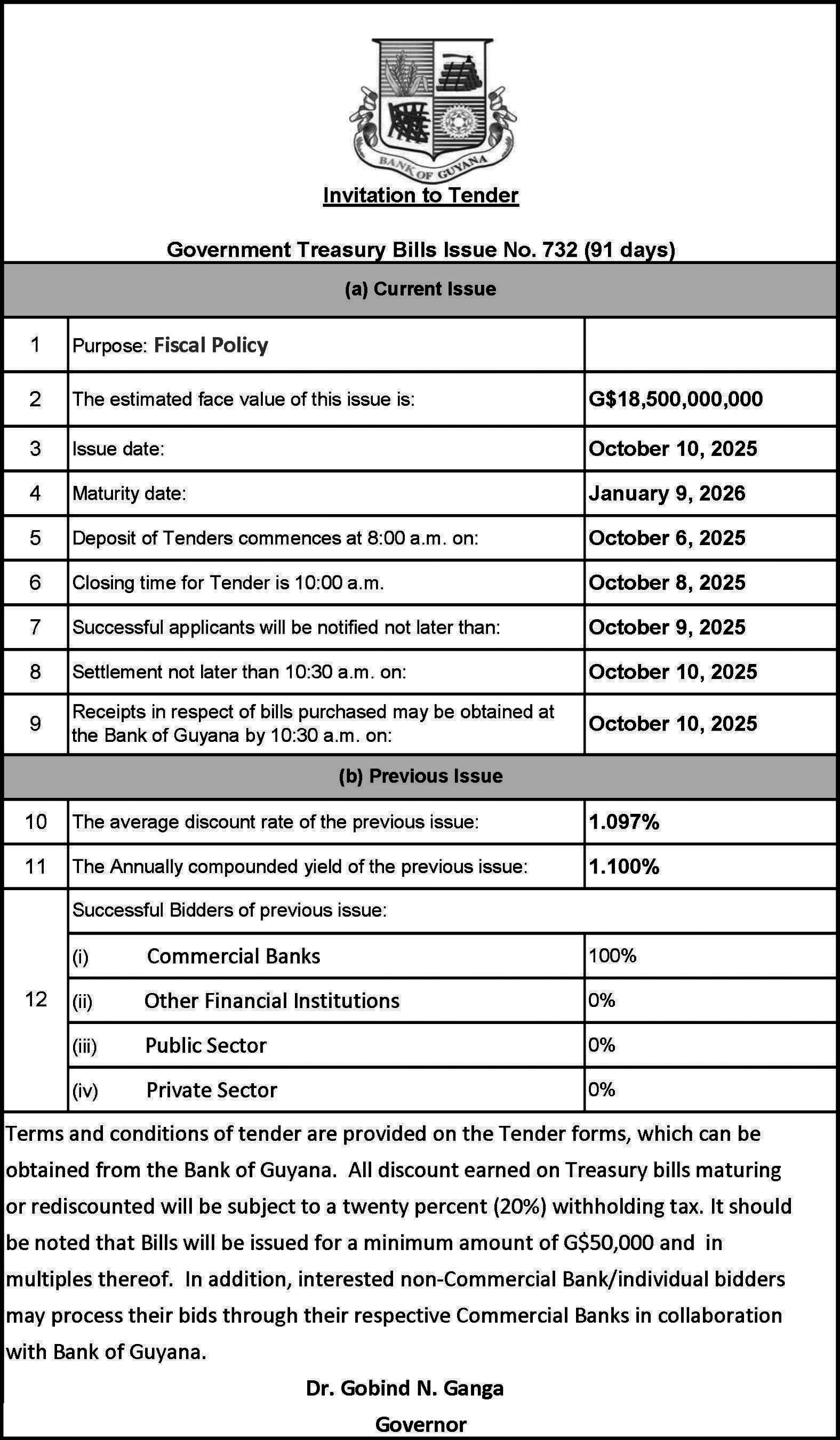
operations across Guyana, particularly in vulnerable districts will be intensified as the interagency task force here looks to implement sever-
al recommendations that have been made in the recent 2025 Trafficking in Persons (TIP) Report issued by the United States Department of State. Guyana was able to
maintain a “Tier 1” ranking and according to the U.S. Department of State, this is evaluated on the basis of its strategies and initiatives to combat trafficking, with a collaborative approach

involving the Guyana Police Force, the Ministry of Human Services, and the Office of the Director of Public Prosecutions.
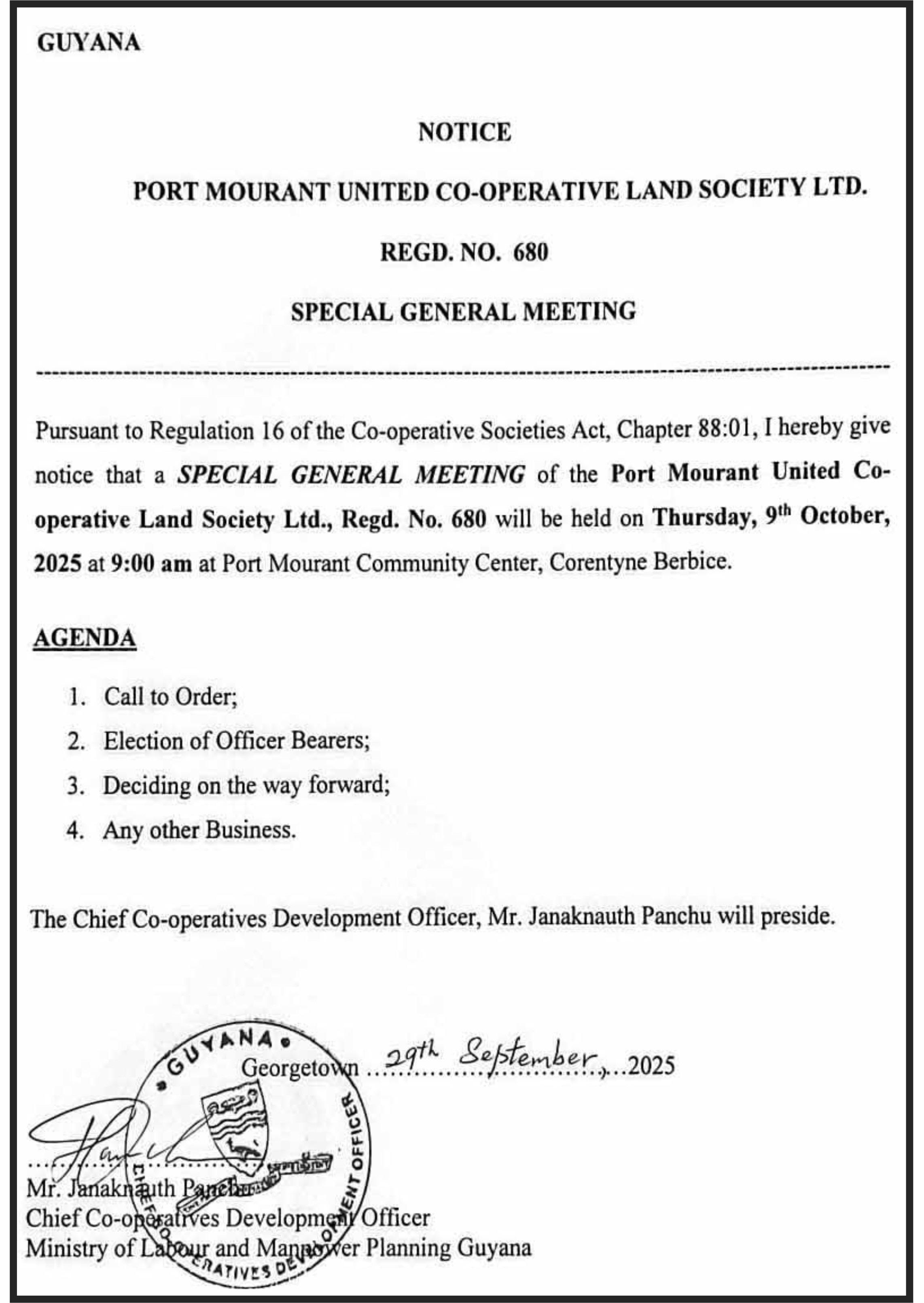
Daniel Griffith, the Coordinator of the trafficking in persons interagency unit here, during an interview with the Guyana Chronicle, shared that the country’s strategy involves assessing trends, adopting techniques, and targeting traffickers based on investigation.
“[The] US State Department assess [sic] countries based on their efforts, and it's broken down into three categories: prevention, protection and prosecution. So, Guyana is evaluated over those three areas in terms of how they implement strategies [and] initiatives to combat trafficking in persons in Guyana,” Griffith explained.
With several mechanisms such as hotlines and the monitoring of social media already established, TIP operations in Guyana have been proactive.
“We assess trends based on what information is provided to us, what data is provided to us and basically adopt techniques to target [and] to prosecute traffickers,” he said.
Last year, 31 trafficking cases were investigated, leading to the prosecution of three individuals on a total of 10 charges. The majority of victims were young women aged 16-26, primarily for sexual exploitation. Support services for victims include accommodation, medical care, and legal aid. The Ministry of Human Services is responsible for victim protection and support.
“From the task force level, you can see more outreaches engagements, particularly in the hinterland community, migrant settlements, mining and foreign street districts. In the construction sector, we have a lot of construction works. And in the service industries, hotels, bars, entertainment spots, the Guyana Police Force will increase anti-TIP operations, gathering of intelligence to basically curb this crime; it's going to be a proactive
approach. We're seeing more engagement with persons on the ground and having further discourse,” he said.
This marks the ninth consecutive year that Guyana has maintained the top-tier placement, which is awarded to countries meeting the highest international standards in fighting trafficking in persons.
The U.S. State Department report highlighted several key advancements made by Guyana over the past year, including an increase in prosecution rates; the conviction of a sex trafficker with an ordered restitution payment; enhanced collaboration with foreign governments to investigate trafficking cases and greater funding allocated to protection and prevention initiatives. However, the report also outlined 12 recommendations for Guyana to further strengthen its anti-trafficking framework. These include: increasing prosecutions and convictions, particularly in cases involving child victims; eliminating recruitment fees charged to workers; expanding labour and spot inspections in high-risk sectors such as mining and logging; enforcing restitution orders promptly; proactively screening vulnerable populations, including migrants, for trafficking indicators; and ensuring convicted traffickers and any complicit officials face adequate penalties.
“It's a whole-of-government approach. We soon will be working to address the 12 priority recommendations expeditiously. As you know, it's over a particular period. Some will take us a bit longer than others, and the work continues to end, combat Trafficking in Persons and combat human trafficking in Guyana,” Griffith asserted.
- says US$1.6B earned since enactment of Local Content Act
By Shamar Meusa
SINCE the enactment of Guyana’s Local Content Act, Guyanese companies have recorded gains upwards of US$1.6 bil -
million, and in the third year, we went to US$704 million,” he said.
For this year, he noted that the growth trend has continued, as he noted that from January to June, the

lion, according to newly appointed Director of the Local Content Secretariat, Michael Munroe.
Munroe was at the time speaking on the ‘Starting Point’ podcast during which he stated, “So just in these 40 areas… we’re in our fourth year of implementing the Local Content Act. We’ve already garnered in excess of US$1.6 billion.”
The 40 areas Munroe made reference to are those areas set out in the Local Content Act, which include services such as accommodation, catering, and food supply, among other things, which must be procured from Guyanese companies.
The director explained that the figures reflect a steady increase in the value of contracts won by Guyanese companies since the law took effect.
“In the first year, we would have seen the companies registered as local-content certified; they would have gathered, I think, in excess of US$440 million. In the second year, we more or less went to US$540
first schedule.
However, the secretariat’s figures, he said, strictly focus on those 40 categories listed in the first schedule of the act.
With the reporting from the company on a broader range of services outside of that schedule, Munroe noted that this was a positive development, which indicated that the international operators are deepening engage-
ments with local suppliers.
“That is a good thing in my opinion, because it suggests that the companies are procuring beyond the first schedule. These companies now want to be a part of Guyana's local content story, and in so doing, they are procuring from local companies beyond the first schedule,” he expressed.
The director went on to note that this shift shows
how the legislation has transformed corporate behaviour, stating, “I think it’s a good indication for us to feel proud that the act is stimulating procurement beyond the first schedule.”
Guyana’s Local Content Act was passed in December 2021 in the National Assembly. It is designed to maximise participation of Guyanese companies in the sector, beginning with
the provision of services such as office space rentals, janitorial services, laundry and catering services, and supply of food, among several others.
As of the beginning of 2025, it was reported that the country’s Local Content Register included over 1,100 companies, pointing to the success of the implementation of the Local Content Act.
number stands at just around US$350 million.
“So, we’re seeing increases year on year. Every half year, we are seeing increases in the level of procurement activity,” he added.
To this end, he projected that Guyanese supplies will likely surpass the previous year’s total as he added that he anticipates that there will be a ramping up of procurement activity.
“I anticipate that there will be ramping up in the procurement activity, and we may, more than likely, if the trend holds true, we will exceed last year’s number, so we will be north of US$704 million,” Munroe said.
Getting ahead, Munroe addressed the difference between the secretariat’s figures and those of oil giant ExxonMobil. He noted that the numbers posted by the company, which were in excess of US$400 million at half year, cater for their procurement spending, which includes things outside of the 40 areas in the

- 85 babies delivered, some 5,000 patients access emergency care, over 7,000 outpatients seen
ADVANCING access to quality, affordable healthcare is one of the many goals of the Government of Guyana.
In July this year, the President, alongside the Minister of Health, commissioned the Enmore Regional Hospital, with the aim of bringing healthcare closer to those persons in the community who need it and decreasing travel time.
The Enmore Regional Hospital, like the others, provides a first-class experience to its visitors, with 24-hour service in the accident and emergency department, a radiology department that does ultrasounds, x-rays and CT scans, outpatient services, and specialised clinics that
are open Monday to Friday, just to name a few. These services and many others are free of cost.
Since its opening in July, the hospital has seen more than 7,000 patients in the outpatient department, and almost 5,000 in the accident and emergency department. Thus far, 85 babies have been delivered at the hospital.
This was stated by the Medical Superintendent at the Hospital, Dr. Tracey Bovell on a recent episode of ‘Health Matters’. She said: “We have a lot of specialists. We have, as I would have mentioned, all of the different specialties that we have. But we also have midwives. We have for nursing. We have our RNs.
We have NAs and PCAs. And we're growing.”
Because it is a young hospital still, Dr. Bovell said the Enmore facility is partnering with the Georgetown Public Hospital Corporation (GPHC) to train staff, increasing their skills and capacity to treat critically ill patients. Additionally, the Enmore Regional Hospital is also partnering with the new Diamond Regional Hospital, Bath Regional Hospital and De Kinderen Regional Hospital.
Speaking on the impact the hospital has had on the community, Dr. Bovell stated, “So the community is welcoming us with open arms; they are happy to have a specialised hospital so close
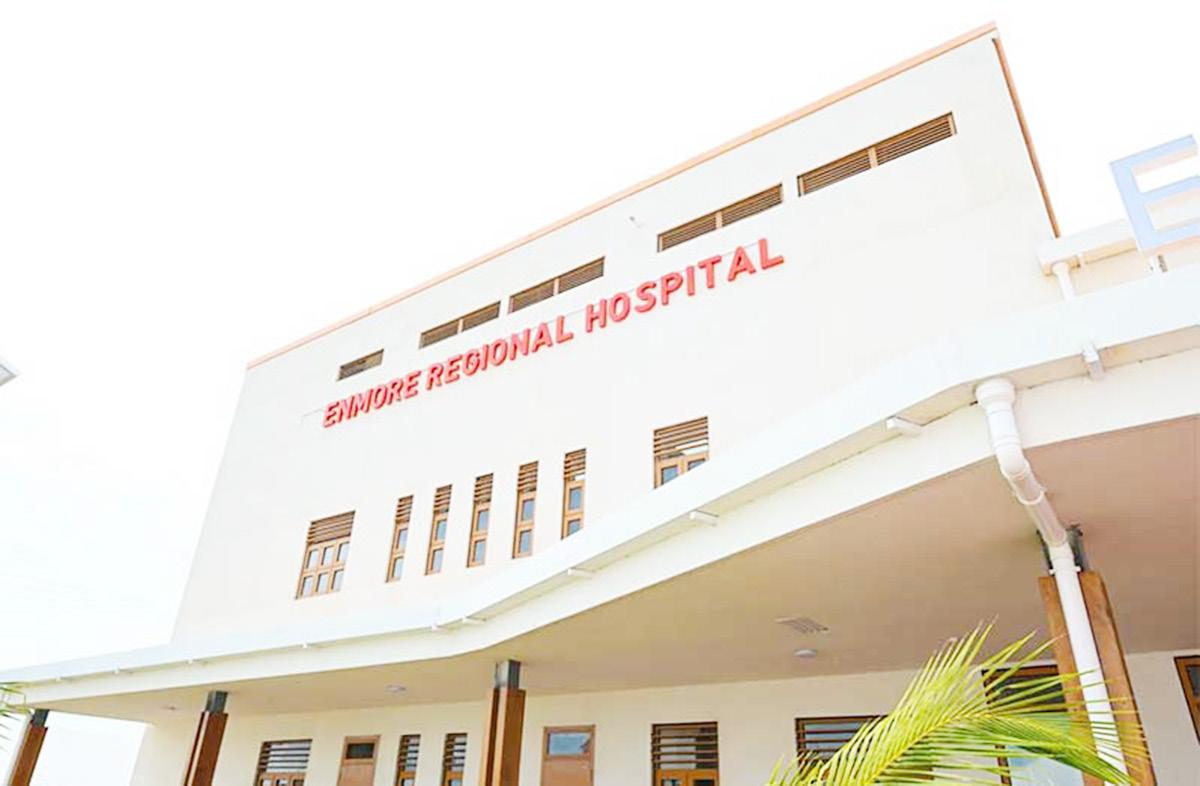
by. They're actually coming to the hospital, being provided with care, and they're getting to know the physicians even better, and checking in with the physicians, even when they don't even need to check in with the physicians.”
The Enmore Regional Hospital is part of a bigger vision of a Guyana where every citizen has access to high-quality, modern and people-centred healthcare, President Dr. Irfaan Ali had said. The hospital was built in collaboration with China’s Sinopharm International, and is part of a broader $37.2 billion national health transformation across the country.

IN a ceremony marked by heartfelt reflection and professional pride, Michael Shaun Hutson was, on October 2, 2025, admitted to practise as an Attorney-at-Law before the courts of the Co-operative Republic of Guyana.
His application for admission was presented by Attorney-at-Law, Tiffanny Castello, be-
Institute, and a Bachelor of Laws Degree completed in 2013.
Most recently, Mr. Hutson earned his Legal Education Certificate from the Eugene Dupuch Law School in The Bahamas in September 2025.
Professionally, Mr. Hutson has served the Guyana Lands and Surveys Commission (GLSC) since 2001
scribed as the culmination of a long and often challenging road, one first inspired by former Land Court Judge, G.O. Brooms, who encouraged him to pursue a legal career.
Mr. Hutson thanked his law school classmates, mentors, tutors, and colleagues, with special mention of Ms. Castello and Ms. John for their guidance and

fore the Honourable Chief Justice (acting), Mr. Navindra Singh.
In her address to the court, Ms. Castello outlined Mr. Hutson’s extensive academic and professional background. From his early education at F.E. Pollard Primary School and Saint Stanislaus College, to his distinguished service in the field of land surveying, Mr. Hutson has built a career rooted in public service.
Ms. Castello detailed his academic achievements, which include a Diploma in Forestry from the University of Guyana, a Diploma in Surveying from the Government Technical
in various capacities, including Manager of Land Administration to his current position as the Deputy Commissioner. His transition into the legal profession, as noted by Ms. Castello, brings with it a wealth of experience and expertise in the surveying profession which will enrich the practice of law in Guyana.
In his address to the court, Mr. Hutson expressed deep gratitude to the Honourable Chief Justice for hearing his application and allowing him to sit in his court during his in-service tenure. He humbly reflected on his journey, which he de-
with integrity and compassion.
“I will always be a student of the law,” he affirmed. “And I pray that I can make a valuable contribution to upholding justice in society.”
The Honourable Chief Justice formally granted the application for admission, officially welcoming Mr. Michael Shaun Hutson to the

the rule, and where
ty to remind the new
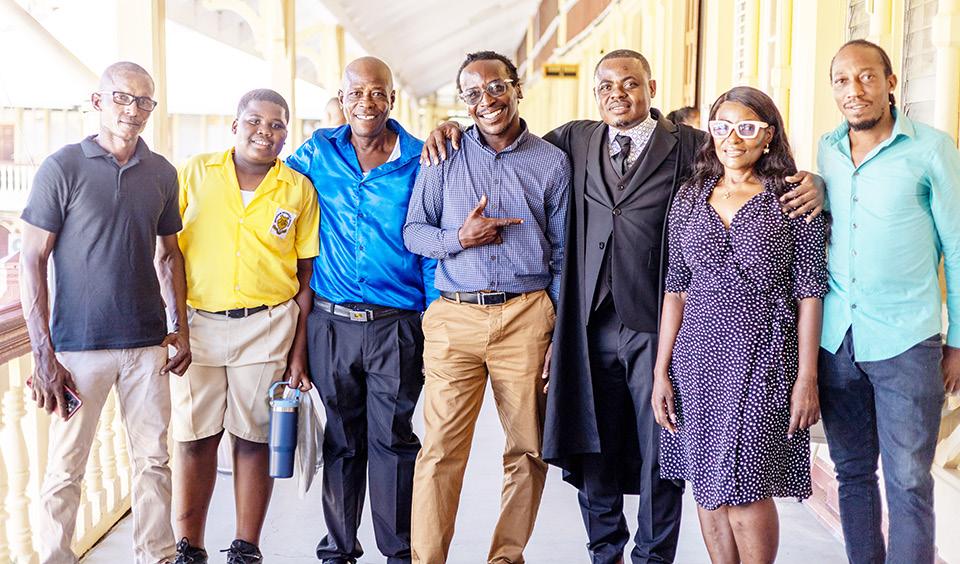
support. He also acknowledged the encouragement and support of the Commissioner, Mr. Enrique Monize, and staff of the Lands and Surveys Commission.
Paying tribute to his family, Mr. Hutson offered heartfelt thanks to his parents, particularly his father, Herckert Hutson, a mason and carpenter with no formal education, whose example of hard work and lifelong learning served as a guiding compass.
In closing, Mr. Hutson assured the court of his continued commitment to the legal profession, pledging to uphold its ethics, values, and traditions
Bar of Guyana.
In delivering his remarks following the admission, Acting Chief Justice Navindra Singh echoed the sentiments of Chief Justice Andrew of the Supreme Court of Connecticut, stating:
“It is not enough for an attorney that he be honest. He must be that, and more. He must be believed to be honest. It is absolutely essential to the usefulness of an attorney that he be entitled to the confidence of the community wherein he practises… But… if once the practice becomes to him a mere brawl for hire, or a system of legalised plunder, where craft and not conscience is
falsehood and not truth is the means by which to gain his end, then he has forfeited all right to be an officer in any court of justice, or to be numbered among the members of an honourable profession.”
Chief Justice Singh used the opportuni -
Attorney-at-Law of the paramount importance of maintaining integrity and credibility before the courts. He cautioned that once the trust of the judiciary is lost, it is difficult to be restored.

THIS is a summary of what was said by UNICEF spokesperson, James Elder, at Friday’s press briefing at the Palais des Nations in Geneva.
“Gaza City remains home to tens of thousands of children. Shoeless children push grandparents in wheelchairs around rubble. Amputee children struggle through the dust. Mothers carry children whose skin is bleeding from rashes. Children shudder at the relentless airstrikes. And children gaze skyward tracking the fire from helicopters and
quadcopters.
“The question I am asked everywhere in Gaza City - from women, from the elderly, and from children - is: ‘Where can I go that will be safe’?
“And the answer remains the same after almost two years: Nowhere.
“Nowhere is safe in the Gaza strip.
“Yet, today, a further 200,000 civilians have been warned to leave Gaza City, in addition to more than 400,000 people who have been forced to move south. One hospital in Gaza City
– the Patient Friendly Hospital where I was yesterday - sees 60 to 80 children each and every day being admitted for malnutrition and other illnesses.
“The Intensive Care Unit (ICU) for infants and newborns at Al Helou hospital is overflowing. This hospital was shelled last week.
“The logic imposed on people in Gaza is both brutal and contradictory. The north has been declared hostile ground: those who remain are to be branded as suspects. Let’s be clear:
the issuance of a general or blanket evacuation order to civilians does not mean that those who remain behind lose their protection as civilians.
“The south—the socalled “safe zones”—are also places of death. AlMawasi, now one of the most densely populated places on earth, is grotesquely overcrowded and stripped of the essentials of survival. Eighty-five percent of families live within ten metres of open sewage, animal waste, piles of garbage, stagnant water or
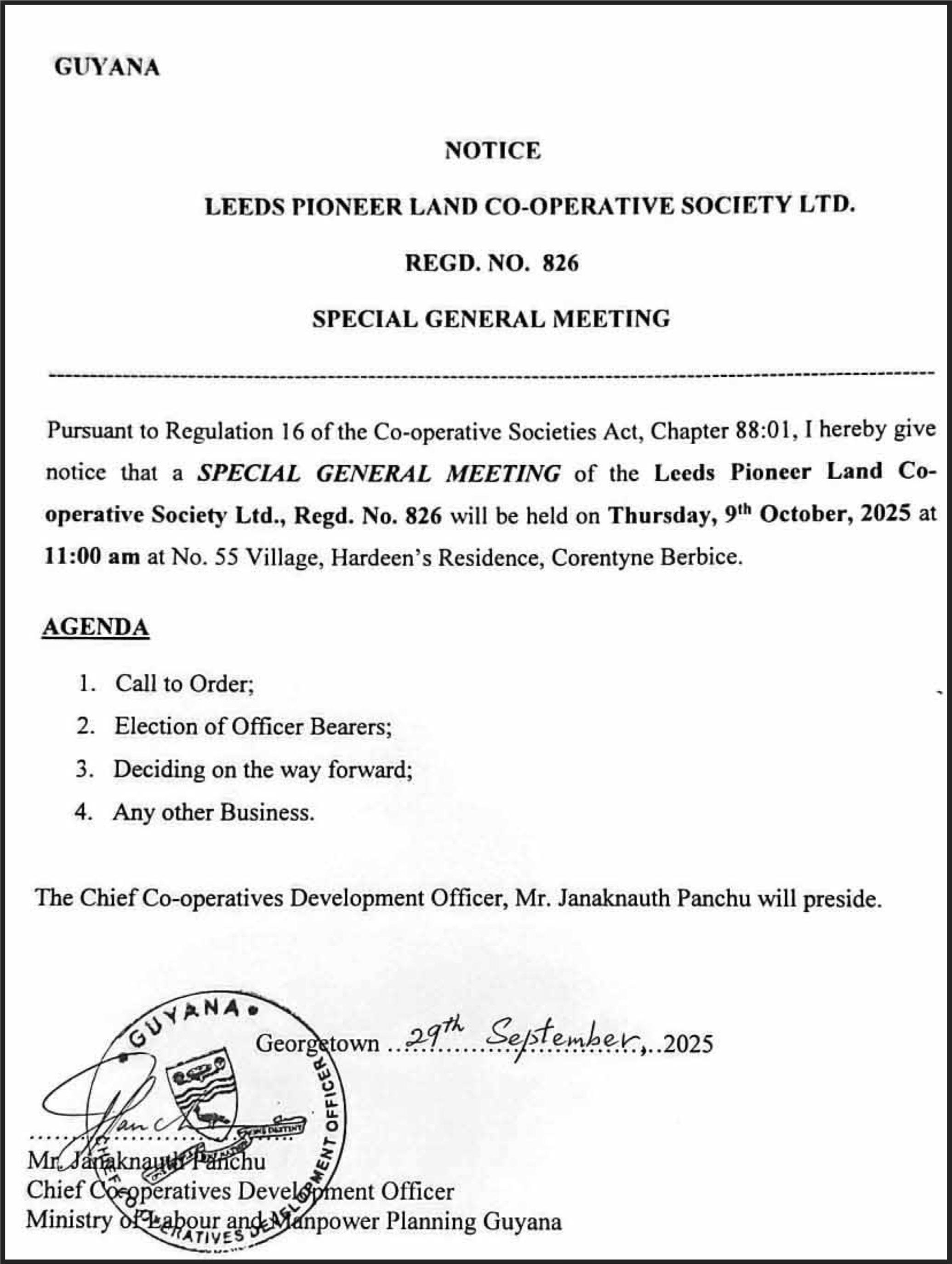
rodent infestations. Twothirds have no access to soap. I spoke with dozens of people in Gaza City who all said the same thing: they have no money to move; no space nor tent to move into, and the south too is dangerous.
“Indeed, the very notion of ‘safe zones’ in the south is farcical — bombs are dropped from the sky with chilling predictability. Schools designated as temporary shelters are regularly reduced to rubble. Tents pitched in empty lots offer no protection from shrapnel. They are frequently engulfed in fire from air attacks.
“Two days ago, I met children in Nasser hospital who have been paralysed, burnt, or had limbs amputated following direct hits on
charged and now waits outside laying on the corridor floor with her mother. Nada weighs two kilograms, less than half of what she should weigh.
“Women are having miscarriages on the exhausting trek from the north to the south. Doctors fear winter viruses have arrived early. Reports state that 1,000 babies have been killed in the past two years, and we have no idea how many more have died due to preventable illnesses.
“Meanwhile, frontline workers are doing the impossible. UNICEF and our partners are still supplying Ready-to-Use-Therapeutic-Food (RUTF) for malnourished babies in Gaza City; while across the Gaza strip repairing water lines; delivering cash assistance;

tents, all at approximately two in the morning. A few days earlier, at Al Aqsa hospital, I met many children who had been shot by quadcopters.
“When the world adjusts and normalises this level of violence and deprivation, something is profoundly broken. The strength of international law doesn’t lie in words on paper, but in the resolve of countries to uphold it.
“Meanwhile, the situation for mothers and newborns has never been worse.
“In Nasser, the hospital corridors are lined with women who have just given birth. In six missions to Gaza, I have never seen it like this. New mothers and vulnerable newborns lying on the floor. Three premature babies share a single oxygen source — each child breathing for twenty minutes, before giving way to the next. A premature baby, Nada, who was in intensive care for 21 days is dis -
providing trauma support, along with lifesaving equipment for babies in hospitals, mental health sessions, and waste collection. But until all restrictions are removed on the entry and delivery of humanitarian aid, the provision of lifesaving aid will continue to be woefully inadequate.
“The media in this press room have been generous enough to listen to UNICEF brief dozens of times since we first bore witness to the carnage in Gaza. In that time, we have reported on a war on children, a famine, and a polio outbreak. Always and only with data and testimonials. And yet somehow, things today are worse than at any of those times. Everyone bares some responsibility for this, but there is only one victim. Yesterday, today, and without meaningful action, tomorrow. Palestinian children.” (UNICEF)
MINISTER of Natural Resources, Vickram Bharrat, on Saturday, attended Apex Education Inc’s secondary level graduation ceremony for students of 2025, where he delivered a powerful feature address, encouraging the graduates to work hard, and emphasising that there is an abundance of opportunities ahead.
In his remarks, Minister Bharrat told the graduates that they are the ones who will continue to build our great nation and carry on the legacy.
Speaking on the many opportunities available to youths today, from free education across the country from nursery to tertiary, skills training among others, the minister noted that today’s youth are moving into the workforce during the most exciting period in Guyana’s history.
This, he said, is the period where many Guyanese will not only have a front row seat in seeing the new Guyana being built out but be a part of this transformational, phenomenal change taking place.
According to the minister, it is the mission and vision of President Dr. Irfaan Ali for young people to be given opportunities to take our country forward.
He expressed that for
the graduates, this is the end of one chapter, and the beginning of another chapter in their lives.
Providing advice for this new beginning, Minister Vickram related that at this stage in their lives, and especially at this age, choosing a career is one of the most difficult things they will have to do.
He encouraged the Apex graduates to choose a career path that they truly want, one that will make their life interesting as they continue to grow.
“You are at that point in time when you really need to put your phones away and sit a few minutes alone by yourself and really reflect on where you are right now and where you want to be five years from today or ten years from today,” Minister Bharrat remarked.
He posited that as young people, they must have their own dreams, ambition, objectives and goals in life. Minister Bharrat told them that each person has their own path and purpose, and different strengths that we can work on and use to build what we want to achieve in life.
“You have put in the effort, the dedication, the commitment that is needed to be here today. So, you truly earned the right to be here today and to be celebrated,” the minister said.

Five students secured eight or more Grade Ones at this year’s sitting of the Caribbean Secondary Education Certificate (CSEC) examinations.
One of the students, Princess Chloe Hunter, attained 14 Grade Ones and one Grade Two, making her the school’s valedictorian.
Ms. Hunter encouraged her fellow graduates that leaving a legacy isn’t about popularity, likes or being someone’s favourite, but about who you are when no one is watching, lifting others as you climb and knowing that the true measure of success is the character you leave behind.
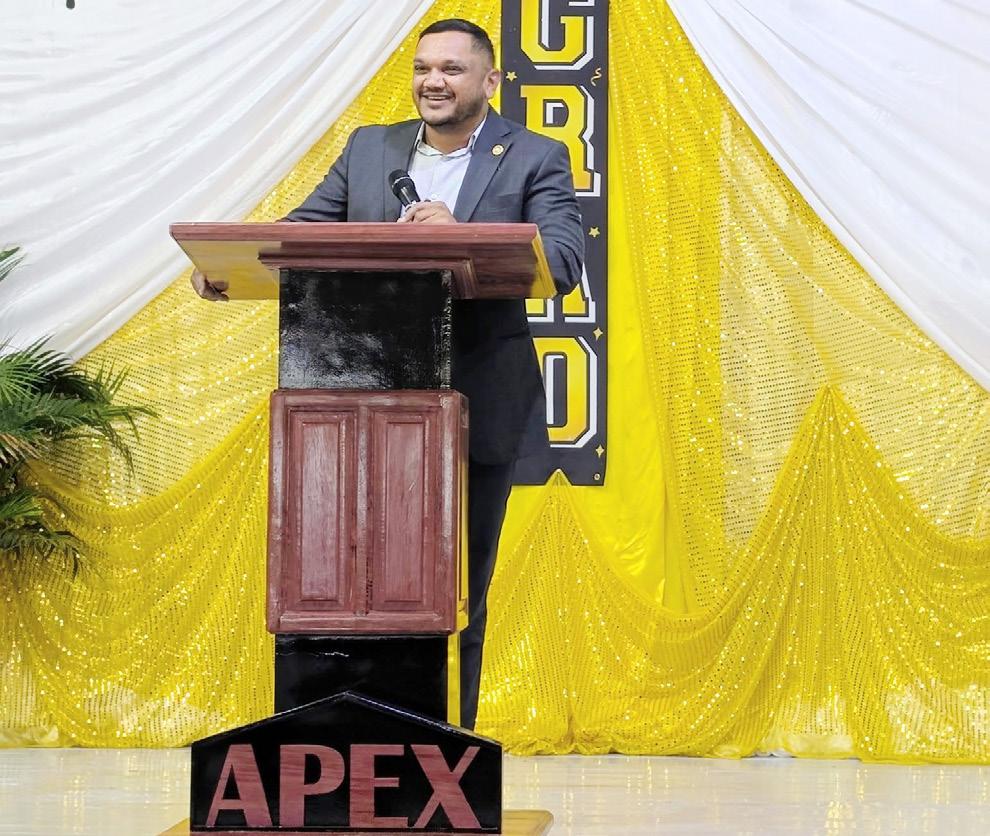


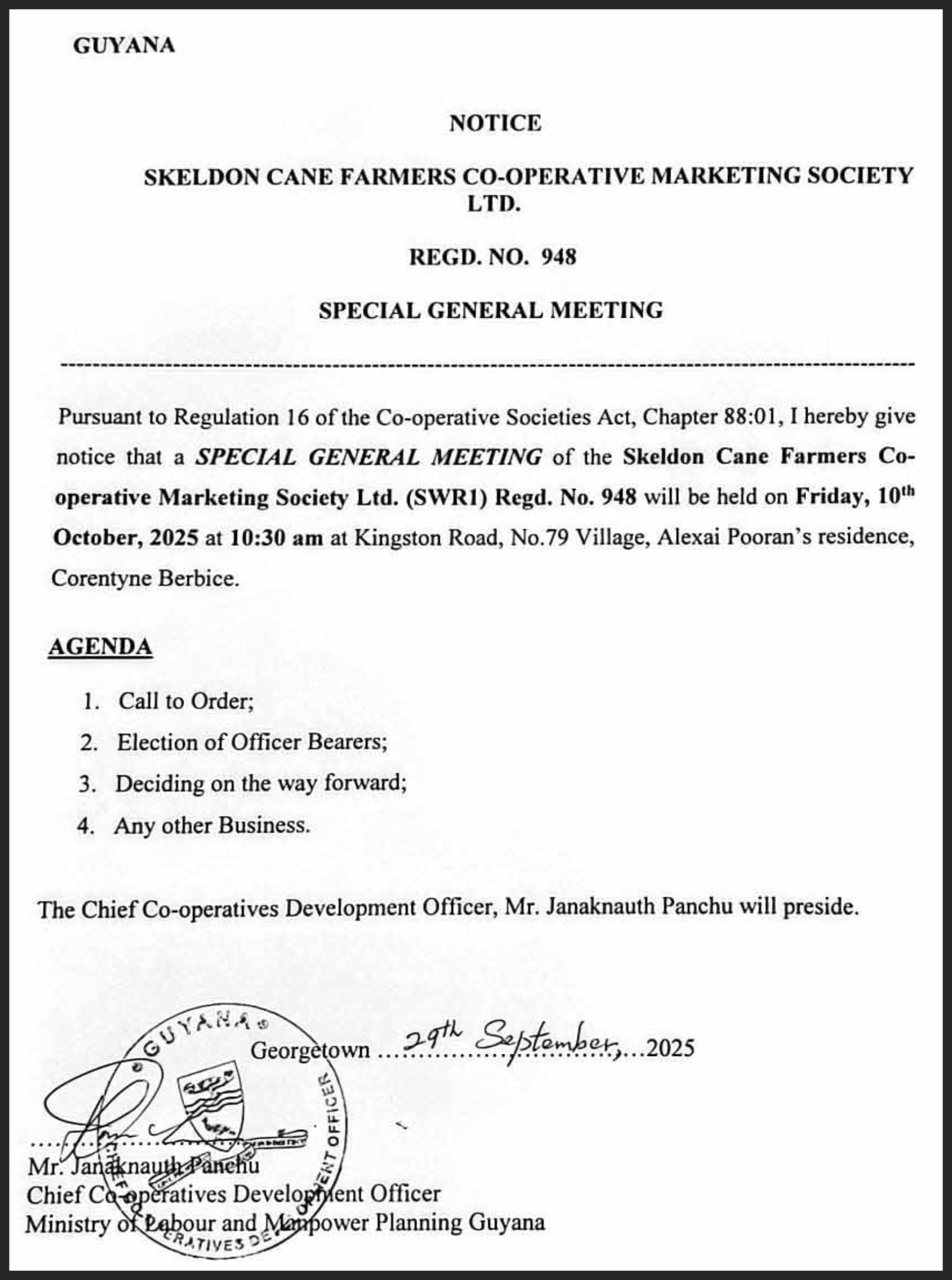
ON October 3, 2025, the Chief Executive Officer (CEO) of the Georgetown Public Hospital Corporation (GPHC), Mr. Robbie Rambarran, had the honour of presenting the CEO Trailblazer Awards to a group of exceptional individuals, in recognition of their outstanding dedication and continued commitment to the hospital’s mission and values over the years These individuals have shown a strong commitment to delivering safe, compassionate, and high-quality care, while supporting their colleagues and contributing to a positive, resilient workplace culture. Their efforts have helped shape the heart of our hospital, creating a lasting impact on patients, families, and the wider community.
“Your commitment to improving patient care and leading with compassion and vision inspires us all,” said Mr. Rambarran during the ceremony.
The CEO Trailblazer Award is not just a mark of recognition; it is a tribute to those whose everyday actions reflect the highest standards of professionalism, empathy, and service. Whether on the front lines or behind the scenes, our awardees represent the very best of who we are.
The hospital extends its heartfelt thanks and congratulations to all recipients. Your dedication continues to inspire, and your work is a vital part of our ongoing commitment to excellence in healthcare. (GPHC)

IN a message to teachers on World Teachers’ Day which was celebrated on Sunday, Minister of Education, Sonia Parag, urged the nation’s educators to recognise their importance and their value.
which we will be able to create support systems, not only for students and parents, but for you the teachers, where we can have open dialogue to solve critical issues.”
To those teachers who have dedicated

She noted the transformation of the education sector, stating that it has seen significance strides under the leadership of President Dr. Irfaan Ali.
The minister remarked that in the next five years, they look forward to building on this, working along with teachers to advance the sector.
She told them, “You have the noble and monumental task of nurturing our young minds into beautiful adults,” before adding, “I look forward to building a partnership with you, one in which there is professionalism and accountability, one in
ers have graduated from the Cyril Potter College of Education (CPCE).
The sum of $175 billion was provided to the education sector to advance the government’s
years of service to this profession, as well as their time and effort to ensure our children perform at their best, Minister Parag thanked them.
In its manifesto, the People’s Progressive Party/ Civic-led Government pledged to improve access to education across the board, from nursery to tertiary, build out schools with modern facilities and increase the salaries and working conditions of teachers.
Additionally, the government at the start of the year committed to improving the number of trained educators in our schools, stating that more than 4,000 teach-
vision of free worldclass education for all Guyanese.
This includes the upgrading and expansion of school infrastructure, cash trans-
fers and the school feeding programme, improving the availability of textbooks and classroom resources, curriculum development and targeted intervention and expanding connectivity and information and communication technology, tertiary education, and technical and vocational training.
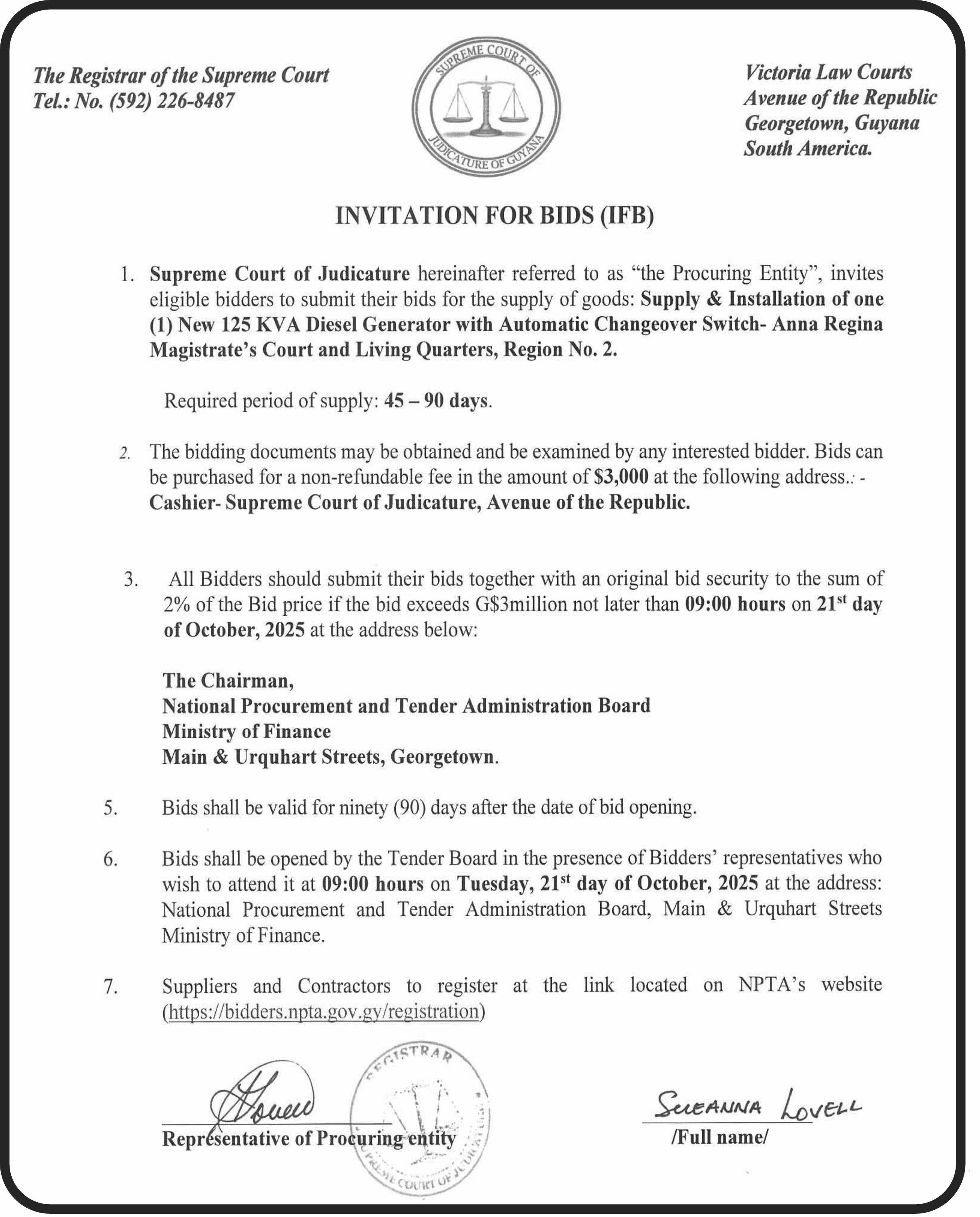
By Michel Outridge
ON the corners of Essequibo Street and Kama-
rang Avenue, Lamaha Springs, sits the National Veterans Rest Home, on a well-spaced land
which provides accommodation for 15 former Joint Services ranks.
This facility has a
complement of 15 staffers on a rotation basis, which includes caregivers, nurses, laundry employees,
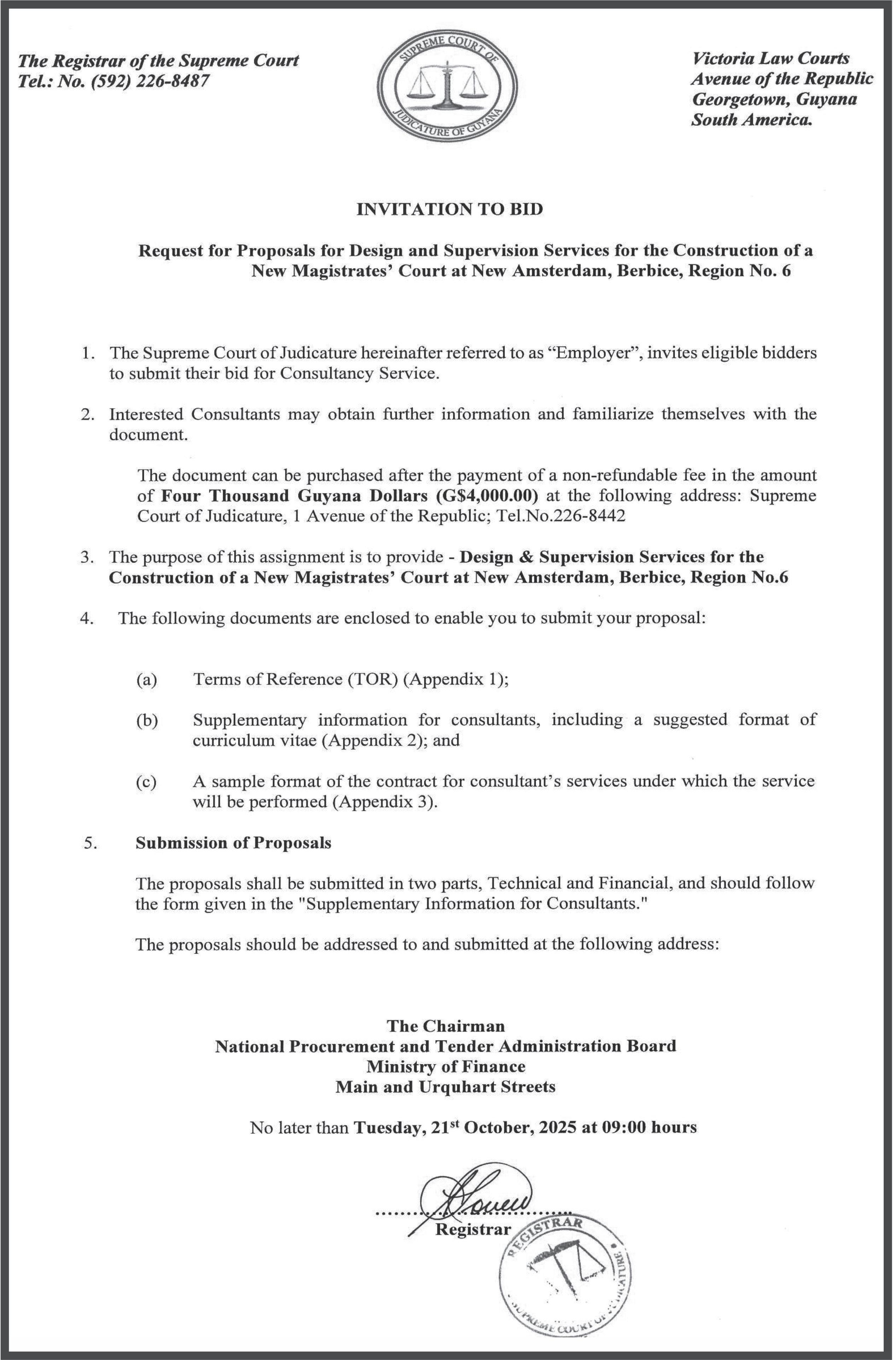
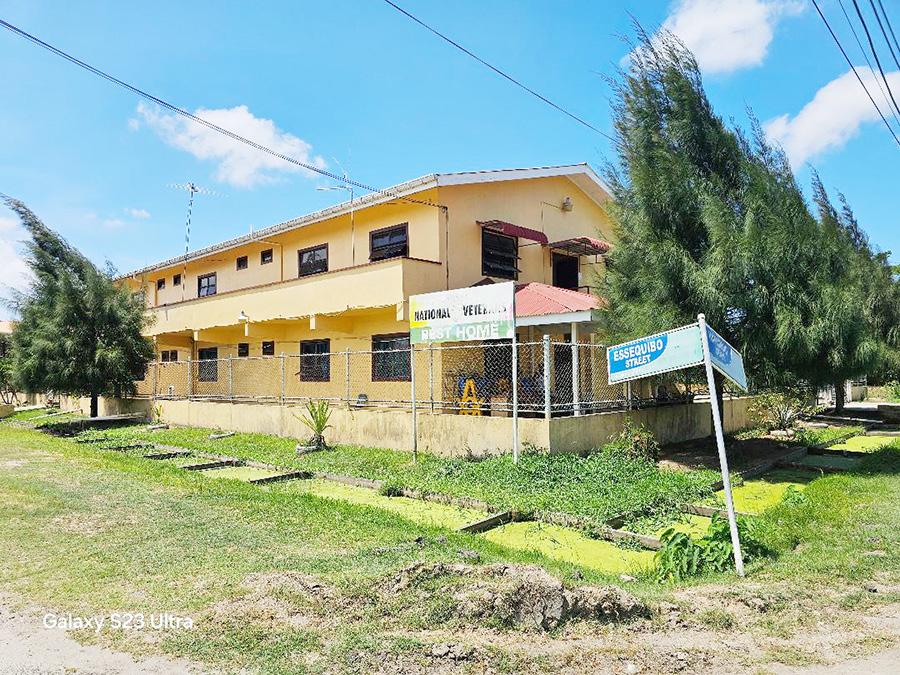
cooks and others.
The Home is supported solely by the Guyana Defence Force (GDF) via a board of directors, and heading it is Administrator La-Sean Semple,

who has a social work background.
She took office in June this year. Prior to this, she was attached to the Georgetown Public Hospital Corporation (GPHC) for 22 years as a social worker, and she also worked at the Ministry of Legal Affairs as a Restorative Justice Officer for six months.
Meals are provided for residents, most of whom served in the GDF and are elderly and retired. The first resident is Ewert Andrews, who is 72 years old, while the oldest resident is 96-year-old Verbert Wilson.
In recognition of World Elderly Day, which was observed on October 1, the Guyana Chronicle visited the National Veterans Rest Home recently and spoke to some of the residents, who detailed their younger days as serving members of the Joint Services.
Richard Robinson, 87, said even though he is visually impaired, he can still see the outline of a person. He spends most of his time listening to the radio as he was when this newspaper visited.
He originated from the Queenstown-Alberttown area, and as a city boy, he served in the Guyana Police Force (GPF) for 34 years as a musician in the Police Band and a policeman. He retired at the level of Chief Inspector.
Robinson has outlived his wives, and is the father of five. He has been staying at the National Veterans Rest Home for the past eight years.
He described his stay as “alright”. During this publication’s visit, he seemed relatively com -

fortable in his bedroom, which he shares with two other residents.
Despite eyesight issues, Robinson was in high spirits as he lay in his bed relaxing after having his lunch.
Meanwhile, Wilson revealed quite a lengthy history of his early years as a serving member of the GDF.
The 96-year-old is originally from Courtyard, Corentyne, Berbice, and at birth his mother became unwell. He was adopted by the midwife/ nurse who delivered him. Her name was Millicent Corlette Clarke, and he went wherever she was posted.
They lived in Mara, Christiansburg, Linden, Bengal, Corentyne, and Letterkenny. He spent the
FROM PAGE 20
early part of his adult life in Linden, working in the army in different job positions before he retired.
His discipline is evident in how he lives and carries himself. He is well-dressed and is very mannerly. Most of his faculties are intact.
Wilson told his publication that he was among 200 workers who were retrenched when the baux-

ite industry in Guyana flopped. After his army life had ended, he was able to secure other jobs.
He was a cane cutter, he worked in the rice fields, and at the rice mills when he returned home to Eversham, Corentyne, Berbice, at the behest of his adoptive mother.
Before he came to the city, he was a member of the Guyana Veterans Legion, serving as the Chairman of the New Amsterdam branch. There, he was admired for his ability to sell more than one million dollars’ worth of poppies for Remembrance Day celebrations to schoolchildren at the schools in that region.
Back then, he was often referred to as “the Poppy Man” by children from Ithaca to Belladrum.
Wilson was married with children, and was staying with a daughter until he became sick. He was sent to the National Veterans Rest Home since he needed a fulltime caregiver. His daughter and her husband both have full-time jobs, and so they didn’t want to leave him home alone.
When his wife passed away, he was living in Mibicuri, Black Bush Polder. He has been at the Home for the past 10 years.
The GDF retiree explained that when he arrived at the Home, the standards were good. He recalled that there was a gardener, caretaker, and the Home was wellstaffed with an in-house doctor and nurses. Additionally, they received extra care. However, over time, the Home reached a rundown state and is now in need of some attention.
He said that some of the staff are not as attentive as the ones before. He, however, singled out caregiver, Doris, whose service according to him is excellent. He said this member of staff is very sympathetic to the needs of the residents, and would listen to them, regardless of the time.
Wilson reported that

some services were withdrawn, and they are only given the basics now. He emphasised that despite these issues, he is grateful for the staff and the services they provide.
He pointed out that the GDF is the only agency that contributes to the upkeep of the Home.
Wilson is of the view that the government should lend some support, since it is the final place of stay for retired Joint Services ranks, many of whom are sick and on the last lap of their lives.
Meanwhile, another resident, Ulric Paul, 75, told the Guyana Chronicle that he served in the GDF for many years, until he retired at age 60. Thereafter, he worked as a contracted driver.
The father of four reported that only his son would visit him at the Home. He had no other choice for accommodation and ended up there.
He has been living
with diabetes for the past 10 years, and it is difficult to cope some days. Despite his ailment, he tries to stay positive.
Paul has been a resident for about a month now, and he is still adjusting. Previously, he
lived with one of his three daughters.
Aubrey Reynolds, 71, is a retired member of the GDF. As a musician, he played bass instruments and still sings. He served for 20 years.
He is passionate about
imparting his knowledge of music to others, and he will do exactly that when the GDF celebrates its 60th Anniversary next month.
He was a member of the GDF Band Corps, and is familiar with the musi-
cal history of the army. The National Veterans Rest Home was officially opened on November 25, 2011 by the then President, Bharrat Jadgeo, to house retired members of the Joint Services.
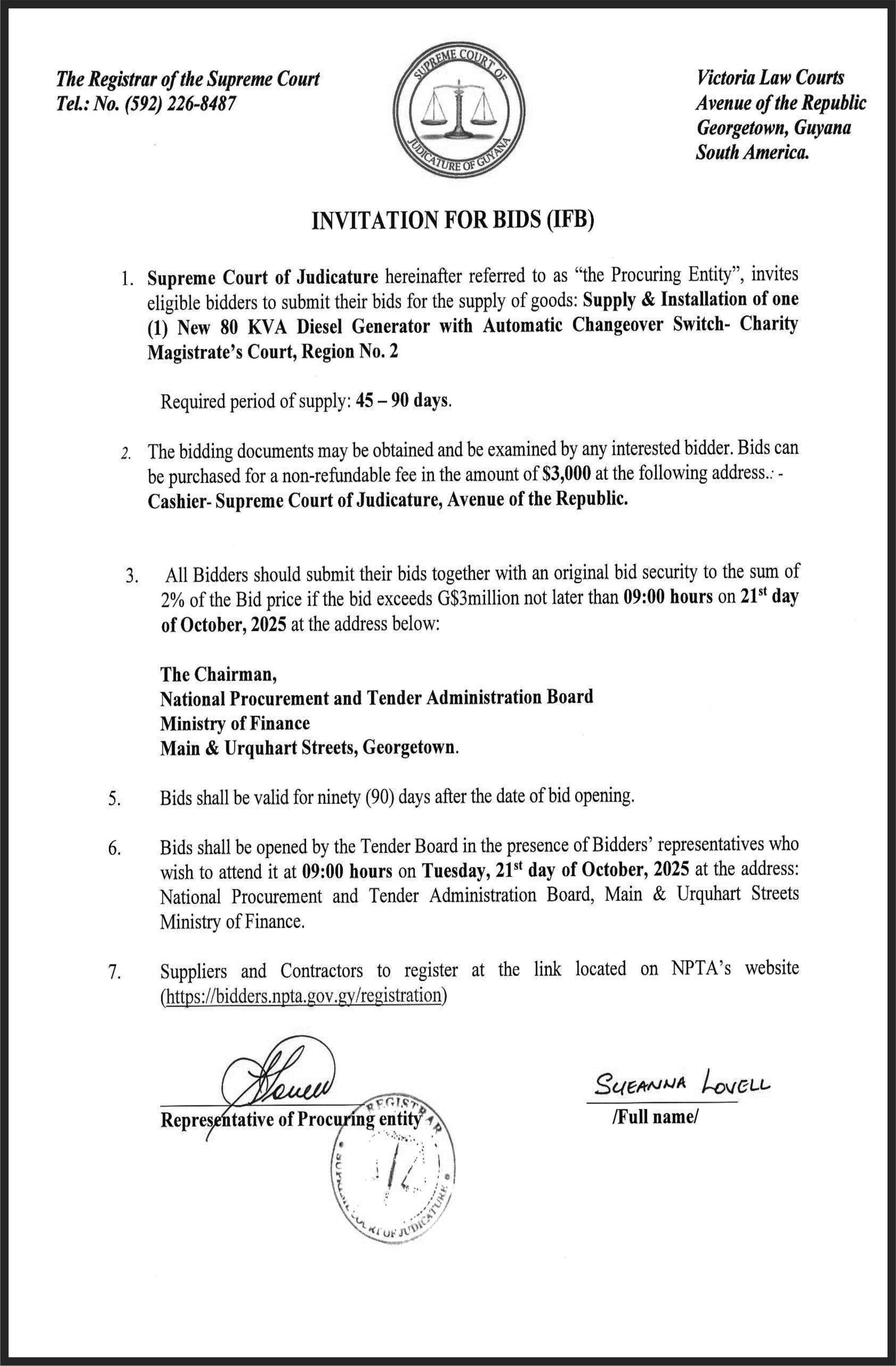





(Monday, October 6, 2025)
COMPLIMENTS OF CUMMINGS ELECTRICAL COMPANY LTD 83 Garnett Street, Campbellville, Georgetown (Tel: 225-6158)
Answers to yesterday’s quiz: (1) Amir Jangoo-74* (Third T20) (2) Aasif Sheikh-68* (Second T20)
Today’s Quiz: (1) What has been the result of the recent WI/Nepal T20 series
(2) Who was voted Man of the Series? Answers in tomorrow’s issue

ENGLISH RACING TIPS PONTEFRACT
08:58hrs Ubetterseethis
09:33hrs Flowstate
10:08hrs Hell Yeah He Did
10:43hrs Fine Interview
11:15hrs Arken Staar
11:50hrs Dreams Adozen
12:25hrs City Captain
STRATFORD
09:05hrs Betty's Tiara
09:40hrs Just Chasing May
10:15hrs Stardrop
10:50hrs Mr Mcloughlan
11:25hrs Fourtowns
12:00hrs Boom Boom 12:35hrs Hay Max
WOLVER HAMPTON
11:20hrs Lee Pelerin
11:55hrs Mc Moan
12:50hrs Henrythenate
13:00hrs Miss Lady Grace
13:30hrs Star Of Atlantis
14:00hrs My Clementine
14:30hrs High Court Judge
15:00hrs Sneaky Blinder
15:30hrs Seconds Count
IRISH RACING TIPS KILLARNEY
08:38hrs Alphecca
09:13hrs Lady Lilac 09:48hrs Ribee
10:23hrs Starting Monday 10:58hrs Marazion 11:33hrs Tilani
12:08hrs Sed Linn
AMERICAN RACING TIPS FINGER LAKES
Race 1 Tiote
Race 2 Candy Is Dandy
Race 3 Back To Khali Race 4 Love Thyself Race 5 Sunday's Currency Race 6 Kings Dancer
7 King's Leap
CMC – Veteran cricket commentator, Joseph ‘Reds’ Perreira believes that Cricket West Indies (CWI) erred by sending a West Indies senior team to play minnows Nepal instead of a developmental team.
The regional side, led by Akeal Hosein suffered a shocking 2-1 defeat against their lower-rated opponents in their recently concluded three-match T20I series in the United Arab Emirates last month.
The result was the first victory for Nepal against a Full Member in any format and sent shockwaves across the cricketing community.
During an interview on Isports on i95.5 FM on Friday, Perreira, who spent over 50 years as a commentator, said it would have been better served to send a young, inexperienced side instead of including some of the senior players.
“We had beaten Nepal
the previous visit with an ‘A’ team led by [Roston] Chase. I didn’t see the need to put the West Indies’ good name on the line by picking the team that they picked.
“I would have gone and I suggested it, with a development team. Some of the players they picked, the younger players with little experience like [Amir] Jangoo, but I wouldn’t have gone for [Jason] Holder, I wouldn’t have gone for [Obed] McCoy, I wouldn’t have gone for [Kyle] Mayers. I would have gone for a development team and we would have at least exposed a number of young men with a development team,” Perreira explained. “I think they focused on trying to win the series. They were more interested in winning the series than development and I think they missed an opportunity. Prior to beating Afghanistan when they were developing, this is their first major victory as a young nation. We have done
them a great deal of good, and they have done us a great deal of harm.”
Furthermore, he said the decision to schedule the Nepal series so close to the conclusion of the Caribbean Premier League placed the West Indies at a disadvantage.
He said they had very little time to prepare after a long flight to Dubai and then played three matches in four days.
“Well it was just rush, rush, rush. If we had in fact been able to agree with CPL to come one week earlier, we wouldn’t have been in the kind of rush that we were.
“There was no camp… we left here the 23rd and it was just too rushed. I don’t believe they were prepared mentally. It’s a long journey to Nepal and their cricket has developed,” Perreira said.
“But why expose the good name of the West Indies to be embarrassed? Just maybe to get a victory to crow about.”
JASMINE Billingy emerged as the new National Women's Singles Champion when the Guyana Table Tennis Association held its Senior National Championships at the Cliff Anderson Sports Hall.
Jasmine Billingy after a bye, faced off with Seona Barker in the quarter finals, which she won in straight sets 11-6, 11-10 and 11-4.
In the semis she battled one of her strongest foes in child prodigy Navaeh Clarkston.
Billingy won the first set 11-7, but Clarkston, with her trademark scream, stepped up to win the second set 11-3 in dominating fashion. However, as was the case in the women's doubles, Billingy settled her nerves to flip the script once again. She went on to win the next two sets 11-9 and 11-5 to advance to the final.
In the final Billingy battled a familiar opposition in her women doubles partner Samara Sukhai.
Sukhai had some good moments of play in the
match with some long rallies, but Billingy knew her opponent’s game too well to take the five-set affair in three straight sets
She eased to a 11-9 first-set win, then the second went to 15 after a deuce, but she kept the momentum to win the third set 11-4 to claim the women's national title to go with her women's doubles crown.
Meanwhile in the B-class open finals, Malachi Moore beat Colin Wong 3-1 to be crowned champion.

By Sean Devers
ON a day blessed with glorious sunshine, Travis Kadir and Brandon Jaikarran scored centuries as the Demerara Cricket Club (DCC) and the Georgetown Cricket Club (GCC) registered victories as the Dave’s West Indian Inc. First Division 50-over tournament which resumed in the city last Saturday.
At the small DCC ground in Queenstown, the home team beat the Muslim Youth Organisation (MYO) by 37 runs in a high-scoring run fest.
Led by 103 with 18 fours and a six by the left-handed Brandon Jaikarran, a pugnacious 76 from 31 balls with nine fours and five sixes from veteran Chris Barnwell, 42 from Alphius Bookie and 41 from West Indies U-19 player Jonathan Van Lange, DCC piled up an imposing 419-9 off 45.1 overs.
The side also had support from Joshua Persaud who scored 37 and 25 from Demerara U-13 Captain Lomar Seecharran.
Left-arm spinner Kelvin Umrou had 4-44 and got support from Sachin Balgobin, 2-113 from nine overs.
MYO put up a spirited fight, but despite a magnificent 161 from 86 balls, decorated with 19 fours and six sixes off the bat of Travis Kadir, MYO fell short of their target.
Damion Cecil blasted seven fours and four sixes in an explosive 29-ball 80, while Chaitram Balgobin smashed seven fours and six sixes in his shot-filled 81.
The 38-year-old Barnwell returned with the ball to take 2-24 while First-Class left-



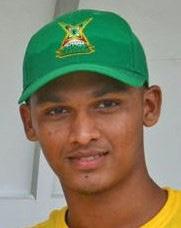
arm spinner Ashmead Nedd had 2-67.
In the other First Division 50-over game on Saturday at the Police ground, GCC defeated Transport Cricket Club by 271 runs.
GCC were dismissed for 359 in 48.1 overs, with the left-handed Akshaya Persaud scoring 70 with five fours and five sixes.
The First-Class player got support from Mavendra Dindyal, who hit three fours and a six in an elegant 57.
Martin Pestano-Bell (44), Renaldo Ali-Mohamed (33), Skipper Devon Lord (30) and West Indies all-rounder Kev-
in Sinclair (28) all passed 25 for the Bourda boys.
Nehemiah Hohenkirk had 3-56, and Ryan Latiff got 2-73 for Transport, who were bowled out for 88 in 15.3 overs, with only Riyad Latiff who hit six fours and a six in 36 making significant contributions.
Carlos Larose, Aryan Persaud and Lord, who is unlucky not to be in the Inter-County tournament after being the leading wicket-taker last year, had three wickets each. Sinclair (1-17 from 3 overs) had the other wicket to fall.


THE passing of Bernard Julien invites reflection on both the brilliance of his cricketing life and the complex times through which he lived. His career reminds us that the story of West Indies cricket is not only about triumphs on the field but about the choices and circumstances that shaped generations of players and the region itself.
Bernard Julien was one of the quiet legends of the 1975 World Cup, a tournament that fifty years ago brought this region joy like no other as the West Indies lifted the first men's world title in the history of the game. His skill and composure were central to that victory. He took 4 for 20 against Sri Lanka, 4 for 27 against New Zealand, and 2 for 38 in the final at Lord’s, along with a vital 26 not out that helped seal the championship.
In all, Bernard played 24 Test matches for the West Indies, scoring 866 runs at an average of 30.92 and tak-
ing 50 wickets at 37.36. In One Day Internationals, he claimed 18 wickets at 25.72. As a left arm swing bowler, his delivery was smooth and rhythmic, capable of moving the ball both ways. With the bat, he combined balance and control with understated confidence. He was admired for his calm temperament and thoughtful approach to the game, a player who brought intelligence and integrity to every performance. His international career came to an end following his participation in the 1982–83 and 1983–84 tours to South Africa, during a period when the world of sport was sharply divided by the moral and political challenges of apartheid. Those decisions reflected the difficult realities of that era and the pressures faced by players navigating competing demands of opportunity, conscience, and circumstance.
As we honour Bernard Julien, we also recognise the importance of reflection and
CMC – Bernard Julien, the outstanding all-rounder and member of the West Indies team which won the 1975 Men’s Cricket World Cup, passed away on Saturday night in Trinidad.
A family member confirmed that he died at Valsayn in north-west Trinidad at the age of 75.
Sir Clive Lloyd, the legendary West Indies captain, hailed Julien as a vital member of the 1975 team which won the inaugural World Cup.
“He always gave you ‘over 100 percent.’ He never shirked his duties, and I could always rely on him
with bat and ball. He gave his all every time … what a fine cricketer,” Lloyd said on Sunday.
“We all had total respect for him. He enjoyed himself and was loved by everyone around. I remember we won the Test match at Lords and stood there and signed autographs for a long time, He was good for us and was held in high regard everywhere we went.”
A left-arm seam bowler and classy right-handed batsman, Julien made his first-class debut at age 18 and his Test debut for West Indies at age 23 on the 1973 tour of England.
During that series he made an immediate impression with a century at Lords, a superb 121 off 127 balls. He added a record partnership with Garfield Sobers who made 150 not out.
During the famous 1975 World Cup in England, Julien claimed 4-20 in a Man-of-the-Match performance against Sri Lanka at Old Trafford and then 4-27 against New Zealand in the semi-finals at the Oval as West Indies reached the final against Australia. He went wicket-less in the final but scored a crucial 26 not out as the West Indies won by 17 runs.
By Sean Devers
inclusion. The time has come to view that chapter of our history not through exclusion but through understanding. Cricket West Indies believes that all who have contributed to our regional game, in whatever context, are part of our shared story. Therefore, the day will be deeply significant when CARICOM, with grace, undertakes a regional act of acknowledgement and pardon, embracing both the living and the departed, as a quiet but profound tribute to the full journey of West Indies cricket.
To the family, friends, and loved ones of Bernard Julien, we extend our deepest condolences. His passing reminds us that a life devoted to purpose never truly leaves us. Cricket West Indies stands with you in this moment of loss, and we hope Bernard knew he was valued and loved by the cricketing family he helped to shape, and that he found peace knowing his contribution will always endure.
IN a battle of the military forces, Police beat the GDF while Everest defeated Transport SC and Malteenoes got a walkover from MYO as action in the Dave’s West Indian Inc. First-Division 50-over cricket tournament continued yesterday.
At Police, a magnificent unbeaten 155 from 117 balls with 17 fours and five sixes by Man-of-the-Match Garfield Benjamen was the highlight of the contest, but could not prevent the GDF from suffering a loss by 63 runs.
In sweltering heat and perfect batting conditions at the Police Sports Club ground, Eve Leary, the GDF, were dismissed for 282 in 39 overs in pursuit of the 345 all out in 45.1 posted by Police.
The reply commenced inauspiciously as Mark Jeffers removed Rockael Reddy (0) to stun the soldiers on 1-1 on a lightning-fast outfield.
Leon Andrews (15) and Benjamen carried the score to 26 before off-spinner Dwayne Dick trapped Andrews LBW and bowled Sanjay Algoo for a duck to be on a hat-trick.
Benjamen was joined Nigel Deodat in the sixth over and the pair embarked on ‘Operation rebuild’ with an entertaining fourth-wicket partnership.
But with the score on 165, Deodat departed after facing 45 balls and hitting two fours and six sixes in an aggressive 68, as the 139-run stand was broken.
Although Benjamen continued to execute some imperious shots he ran out of partners.
Leon Swammy (14) and Zameer Nazeer (10) were the only two batters to reach double figures.
Dick, Antony Adams and Kanalya Ramkarran had two wickets each for the Cops, who were spearheaded to their total by half-centuries from Kemol Savory (69) and Ramkarran (53).
Pernell London (37), Quinton Sampson (35), Adams (34), Dick(31) and Chemroy Kendell (30) all got into the 30s.
Andrews took 4-78, former West Indies youth pacer Isiah Thorne grabbed 2-52 and Deodat had 2-46 for the soldiers.
Over at DCC, Everest chasing Transport’s 255 all
out in 48 overs, reached 256-5 in 43.5 to win by five wickets.
National opener Matthew Nando made 68 with nine boundaries at the top, while national off-spinning all-rounder Richie Looknauth fell two short of his century when victory was achieved with Looknauth unbeaten on 98 from 93 balls with 12 fours and three sixes. Ushardeva Balgobin had earlier chipped in with 34.
Myhiem Khan and Riyad Latiff had two wickets each for Transport who began solidly before falling away toward the end.
Romeo Deonarian (65) and Riyad Latiff (64) shared in an117-run opening stand before Jaden Campbell (55) and Deonarain put together 59 for the second wicket. However, only Nehemiah Hohenkirk (22) of the others reached 12.
Left-arm pacer Chris Harry had 3-47, former West Indies batter Assad Fudadin took 3-46 and off-spinner Rafael Singh had 2-23. At Malteenoes, the home side got a walkover from MYO which comprises mostly players from Berbice.
PRESIDENT of the Guyana Football Federation (GFF) Wayne Forde says that they are still awaiting the finalised engineer’s design for the long touted Blue Water Shipping Stadium.
The stadium is set to be built with financial support from Blue Water Shipping Company on a plot of land at D’urban Park.
The GFF President was speaking to the media recently and said there was a delay in the delivery of the design which is expected soon.
According to word, “We had announced that we would have the tender document and we had agreed timelines with our engineering partner, unfortunately they were not able to meet those timelines and we are very patient with them because it is a very

complex design process and they are being very careful.

ed because it easily about 16 million dollars to clean that 7.3 acres of land.”
The GFF president also provided an update on another of the body’s ambitious plans to build full-size all-weather pitches around the country, saying work will not likely begin on those until 2027.
It’s better to go back and look at elements of the design before we just hastily try to meet the timeline; we have been assured that within a matter of days we will have that.”
their benefactor for financing.
He says after completion of the engineering design, they will then engage stakeholders and a FIFA assigned expert before approaching
Schools’ boys opened the day with an emphatic win over St Aloysius Primary 6-nil as action in the Courts
Optical Pee Wee Football Championship continued.
Troy Boston and Adon Holmes recorded hat-tricks in the win.
Potaro Primary then edged Smith Memorial Primary 3-1 thanks to Lamon Telemaque who registered a brace with goals in the 7th and 15th minutes.
His goals came either side of Smith Memorial’s Derick Holder’s strike in the 11th minute.
Marek Timmerman was Potaro’s other goal scorer.
Clonbrook Primary suffered a 5-nil thrashing at the hand of Agatash Primary.
“Then after that we meet with the Blue Water team, because we have to now discuss the business side of things and then the tender will be launched, my team and I are really pushing to have that commence this year,” Forde added.
The long-time football administrator says that they have avoided clearing the ground until they are ready to begin construction because of the cost associated.
“If I went and weed this today, next week it will be the same thing, so we are timing this up until we are nearing the commencement of construction then we will go ahead, any money that goes into to that will be wast-
“Those are in the discussion; we recently submitted a draft MoU to the Government of Guyana because FIFA has asked us to do this in partnership and collaboration with the government. We are very optimistic that we will sign that at some point of time where the roles and responsibilities of FIFA, GFF and government will be clearly identified and we could push ahead with those projects, those are still part of our strategic plan, I don’t see us doing any of those in 2026.”
St John the Baptist was the day’s biggest winners with a 10-nil margin over Ann’s Grove Primary.
Neymar Edwards scored a hat-trick to put them on their way before Aaron Christian came to the party with six goals to seal the contest for St John.
Alex Pearson capped of the victory with his strike in the 30th minute.
Georgetown International Academy (GIA) also achieved an upset with a 3-nil win over St Stephen’s Primary. GIA’s Zakaria Zemmit led with a pair of goals while Caleb Tan scored the other goal.
Another major upset was Leonora Primary beating St Pius Primary 2-nil with goals coming off the boots of Elyon Hyman and Adrian Harry.
Agatash Primary’s Carlos Paul was the talisman with a double, complemented by single strikes from Justin Calvan, Deon Tracey and Jake Calvan scoring the other goals.
North Georgetown Primary led by a pair of goals from Avion Lynch in the 6th and 25th minutes beat Goed Fortuin Primary (2-0).
Redeemer Primary was also edged by Winfer Gardens Primary 1-nil with an Omari St Hill strike.
West Ruimveldt also soundly beat Sophia Primary 5-nil.
Ceon Rajkumar led with a brace with goals also coming off the boots of Jaseen Paris, Chappelle Daniel and Yanique Cadogan.
Stella Maris Primary also continued their winning ways against St Mary’s Primary 4-nil with Kenyeatha Junor scoring a double.
Genesis Academy and St Theresa’s Primary played to a one all draw while Batavia Primary also went down to Tucville Primary 1-nil with a Dominic Dickson goal.
(CMC) - FINANCIAL struggles and inferior playing conditions in the Caribbean are contributing to the West Indies’ poor performances on the cricket pitch, says Test captain Roston Chase.
Chase made the comments following his side’s humiliating loss by an innings and 140 runs to India inside three days in the opening Test match on Saturday.
However, he maintained that he was not looking for an excuse for his side’s recent struggles after they had slumped to their fifth Test defeat in six matches this year.
It was also the fourth consecutive Test match that the West Indies had lost inside three days, dating back to the home series against Australia in July.
Speaking in a post-match press conference on Saturday, Chase said there was a
need for improved infrastructure as well as better pitches and playing conditions.
“…What I would say is that obviously there is a struggle in the Caribbean for finances, so whatever help we can get I hope that they do get it so that they can strengthen the infrastructure for the cricket.
“I think the systems in the Caribbean are a bit poor in terms of training facilities and stuff, but I’m not using that as an excuse or something to hide behind for our poor performances that we’ve been putting out lately. I still think the onus is on the players to find some way to churn out runs and wickets,” Chase said.
The skipper said playing conditions in the region made it difficult for them to be competitive on the international stage.
He said batters in partic-
ular found it challenging to score runs, as was evident in the series against Australia where not a single batsman scored a century.
“…The pitches in the Caribbean are not really batsmen friendly, so guys don’t really bat for long periods and score those big scores.
“And the outfields in the Caribbean are really slow, so when you hit the ball in the gaps and you think you have four, you probably end up with just two, so those are some of the problems that we’re faced with in the Caribbean, so that’s why you see guys averaging so low,” Chase explained.
“If you look at the past series that we had against Australia, I think that’s the first time I’ve ever played an international series and a batsman never scored a hundred in three matches.”

